Oh of course Google scientists have demonstrated a genuine “time crystal” for the first time ever. “The consequence is amazing: You evade the second law of thermodynamics.”



This site is made possible by member support. 💞
Big thanks to Arcustech for hosting the site and offering amazing tech support.
When you buy through links on kottke.org, I may earn an affiliate commission. Thanks for supporting the site!
kottke.org. home of fine hypertext products since 1998.
Entries for July 2021
The HD Video Feedback Kinetic Sculpture
Here’s a description of what the machine featured in this video does: “The HD Video Feedback Kinetic Sculpture creates fractals and organic-looking images in real-time, without a computer: this is old-school video feedback.” But just watch the video for the full effect — this thing produces some amazing imagery.
This is part sculpture, part performance art, and may make the most complex video feedback ever created, using three cameras, two video switchers, a sheet of beam-splitter glass, and an HDMI input from a phone or live video feed.
Much like a musical instrument, the operator at the helm of this device plays it, but instead of making sounds, makes entire worlds, spirals within spirals, loops within loops, galaxies, classical fractal imagery and primordial organisms, leaves, trees, and insects. It really is the God machine.
Lora Webb Nichols’ Photographic Chronicle of the 20th Century American West



This is fantastic: for more than 60 years beginning in 1899, Lora Webb Nichols captured and collected about 24,000 photographs of life in a small copper-mining town in Wyoming.
On October 28, 1899, Lora Webb Nichols was at her family’s homestead, near Encampment, Wyoming, reading “Five Little Peppers Midway,” when her beau, Bert Oldman, came to the door to deliver a birthday present. The sixteen-year-old Nichols would marry the thirty-year-old Oldman the following year, and divorce him a decade later. The gift, however — a Kodak camera — would change the course of her life. Between 1899 and her death, in 1962, Nichols created and collected some twenty-four thousand negatives documenting life in her small Wyoming town, whose fortunes boomed and then busted along with the region’s copper mines. What Nichols left behind might be the largest photographic record of this era and region in existence: thousands of portraits, still-lifes, domestic interiors, and landscapes, all made with an unfussy, straightforward, often humorous eye toward the small textures and gestures of everyday life.
You can browse the collection of her photos at the American Heritage Center at the University of Wyoming.
The US poverty rate is expected to be *cut in half* this year due to pandemic relief efforts from the federal government. Presumably after those efforts end, poverty levels will go back to “normal”.
How Taiwan Held Off Covid-19 (Until It Didn’t)
This video from Vox takes a look at how Taiwan avoided a Covid-19 outbreak for more than a year (and kept total deaths to just 7 in 2020 in a country of 23.6 million) while residents were mostly able to go about their normal lives. The video features photojournalist Ed Ou, who underwent a mandatory 14-day quarantine when he traveled to Taiwan last year. Ou had this to say after spending time in Taiwan, doing normal things without lockdowns or restrictions:
This was an alternate universe of what America, and the rest of the world, had seen all year. The Taiwanese people had been able to just live their lives, as if nothing had happened. Like, to me, that’s freedom.
After more than a year of almost no cases, Taiwan experienced its first Covid-19 outbreak in May (after relaxing their quarantine rules and, presumably, the rise of the delta variant) but has since gotten it under control. Other countries that had been successful in controlling the virus until recently — like Vietnam, Thailand, and Mongolia — are also seeing outbreaks now. When the rest of the world is teeming with the virus, it becomes more likely over time that even the most organized and protected systems are going to be vulnerable.
Philosophical CAPTCHAs
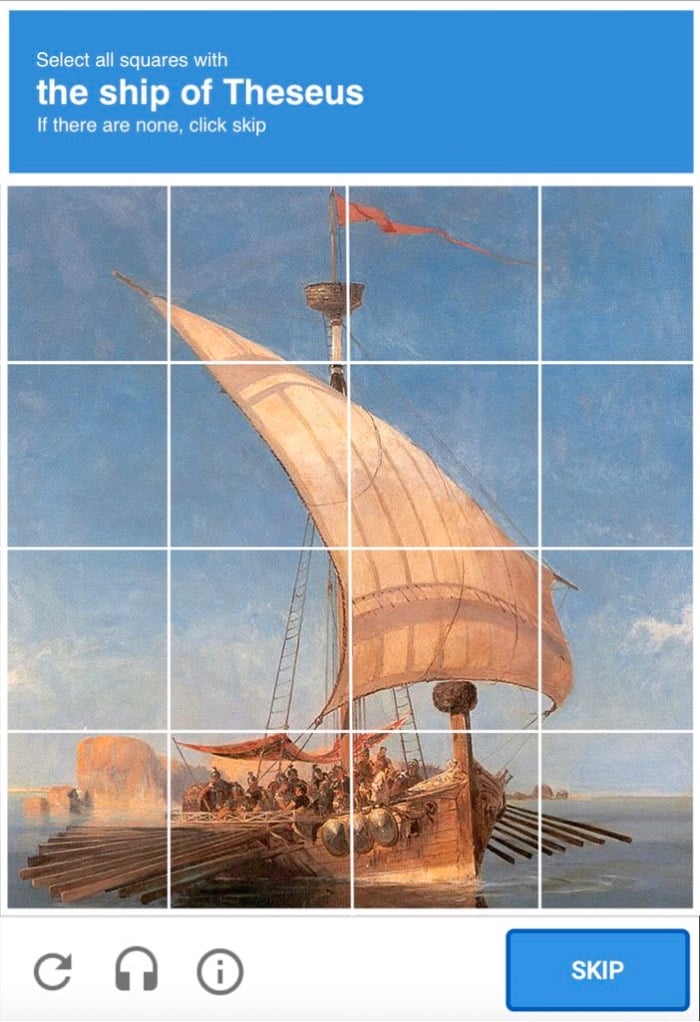

The ship of Theseus image is from Brooks Sterritt and Magritte’s pipe is from Noah Veltman.
Update: See also Mine Captcha from XKCD:

What if the Unvaccinated Can’t Be Persuaded? ~15% of Americans just won’t do it unless forced and it’ll take many months (if not years) of education & outreach to reach another 15% who aren’t. *sigh*
Minimalist Creative Funny Photography





Spanish photographers Anna Devís and Daniel Rueda cleverly use landscapes and architectural elements to create minimalist and fun portraits of themselves. You can check out more of their work on Instagram. (via moss & fog)
From the first time, scientists have been able to observe x-rays coming from the back side of a black hole, which were bent around the hole and toward us. Einstein’s general theory of relativity remains undefeated.
How TikTok’s Algorithm Figures You Out
Using dozens of bot accounts, The Wall Street Journal did an investigation and determined that TikTok’s algorithm needs only one piece of information to determine what you want to watch: the amount of time you spend watching individual videos. Observing your watch time and rewatching is enough for them to fill your “For You” page with recommended videos that are right in your wheelhouse after just an hour or two. That this happens so quickly and completely — 90-95% of what users see on TikTok is algorithmically determined — leads to users going down narrow-interest rabbit holes that can be dangerous, e.g. if someone’s Covid interest turns into anti-vax QAnon crap or sadness turns into video after video about depression or harming yourself.
As someone who built an entire web app that collected people’s social media likes/faves, this focus on a single signal is fascinating. API limitations and rate limits on the number of requests would keep you from building a service with a TikTok-like algorithm for Twitter or Instagram that used likes as the only signal for whether to show someone a piece of content or not, but if you could, I bet it would be amazing.
Huh, Gawker is back? RIP that old rainbow logo.
The Twisties
Yesterday, world champion gymnast Simone Biles removed herself from the women’s team final at the Olympics after not doing one of the planned two-and-a-half twists on her vault and stumbling on the landing. Biles said after the final:
I just felt like it would be a little bit better to take a back seat, work on my mindfulness. I didn’t want to risk the team a medal for, kind of, my screw ups, because they’ve worked way too hard for that.
On Twitter, former gymnast and diver Catherine Burns explained that Biles was likely experiencing a case of “the dreaded twisties”.
When you’re flipping or twisting (or both!) it is very disorienting to the human brain. When training new flips and twists, you need external cues to learn how it feels to complete the trick correctly. (In diving, a coach yells “OUT” and you kick your body straight and pray).
Once you’ve practiced a trick enough, you develop the neural pathways that create kinesthesia which leads to muscle memory. Your brain remembers how your body feels doing the trick and you gain air awareness.
It’s like driving a car, she explains. At first everything you do is unnatural and requires deep concentration to learn but once you’ve got it down, you can do it instinctively, without thinking or even paying that much attention. Then sometimes, in stressful situations, you start thinking too much about how to do the familiar thing and you lose it completely:
Suddenly, in the middle of driving on the freeway, right as you need to complete a tricky merge, you have totally lost your muscle memory of how to drive a car. You have to focus on making you foot press the pedal at the right angle, turn the steering wheel just so, shift gears..
It’s terrifying. You’re moving way too fast, you’re totally lost, you’re trying to THINK but you know you don’t usually have to think to do these maneuvers, you just feel them and do them.
The twisties are like this, and often happen under pressure. You’re working so hard to get it right that you stop trusting your muscle memory. You’re getting lost in the air, second guessing your instincts, overthinking every movement.
And when you’re driving a car or performing a high-intensity sport like gymnastics, second guessing and overthinking can cause serious injury.
I used to write a lot about this kind of thing in this loosely connected series of posts on relaxed concentration. This phenomenon goes by many names — performance anxiety, stage fright, choking, the yips, cueitis (in snooker), and target panic (for archers) — and the world-class are not immune. Daniel Day-Lewis had stage fright so bad he quit the stage decades ago — an affliction he shared with Laurence Olivier, Barbra Streisand, and Mikhail Baryshnikov. If you’ve read anything at all about this stuff, Biles’ case of the twisties doesn’t seem so unusual or mysterious — it’s just one of those things that makes her, and the rest of us, human.
Update: I’d missed this yesterday: Biles herself told reporters about the twisties.
They saw it a little bit in practice… having a little bit of the twisties.
Which is something she’s struggled with before:
The twisties are an issue Biles has faced before, including in the lead up to the 2016 Olympic Games in Rio and prior to the 2019 season.
“2019, at the beginning of the year, I forgot how to twist and flip. It was great,” Biles told Olympics.com in January 2020.
Visualization of Conservative America’s Vaccine Refusal
Charles Gaba has been graphing the Covid-19 vaccination rates of the 50 states (and DC) against the percentage of people who voted for Donald Trump in 2020 and there is unsurprisingly a clear correlation between the two:

As one commenter noted, all of the solidly “blue” states are above the vaxxed national average and all the solidly “red” states are below it. The picture is a little more muddy when you look at the rates at the county level:
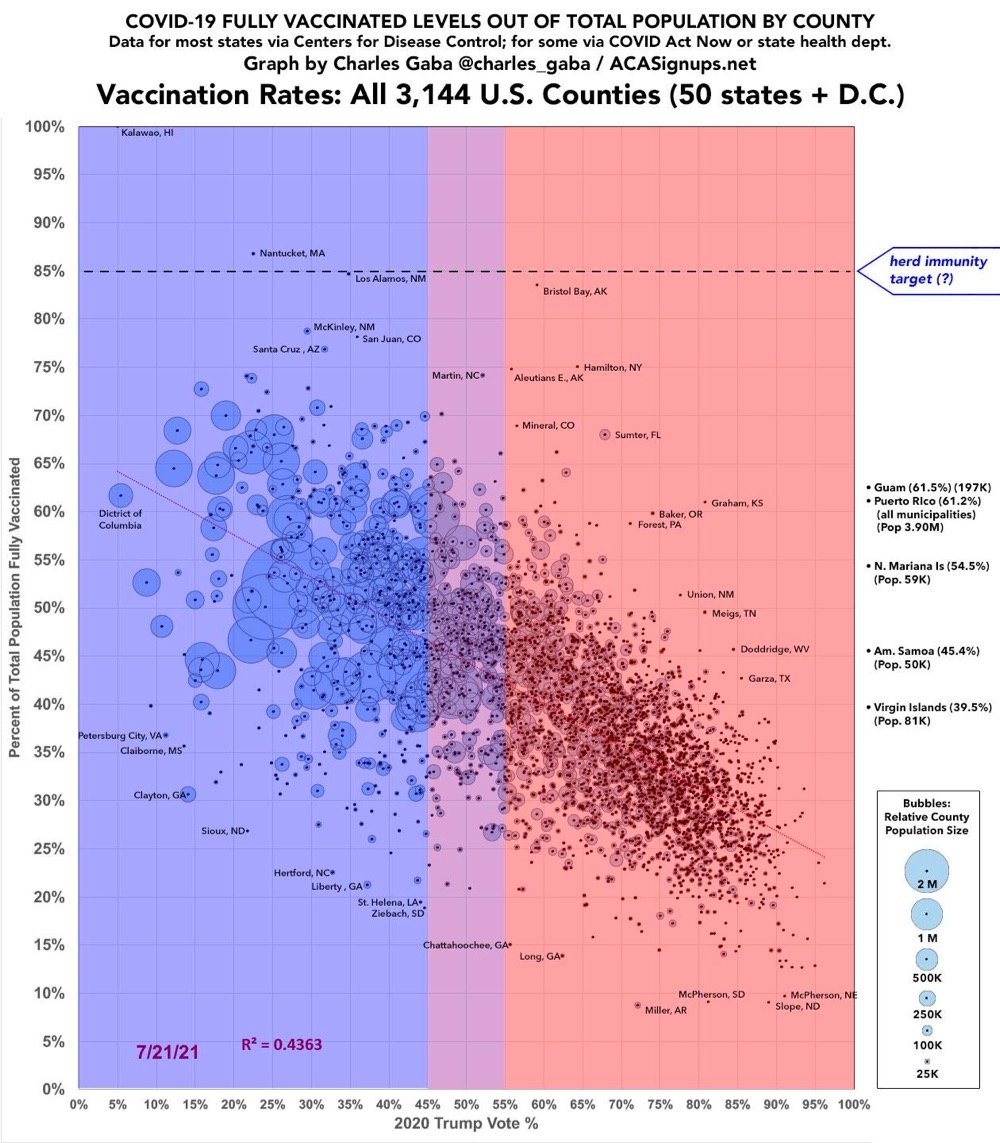
The “conservatives are unvaxxed” trend is still there, but a lack of access and education around the vaccines in counties with large Black and Latino populations also plays a large role in whether people are vaccinated or not.
“Two bartenders floated in and out of the conversation, dropping comments like ‘what’s Covid?’ to laughter. Just recently, a beloved cook at the restaurant had died from the virus, they said.” This is a horrifying portrait of contemporary America.
“If It Doesn’t Shine In Your Face, You Don’t See Anything”

As I’ve written before, in the history of astronomy and astrophysics, women have made major discoveries and played a significant role in advancing our understanding of the universe but have often not gotten the recognition their male peers enjoy. In 1967, while she was working on her doctoral research with her advisor Antony Hewish, Jocelyn Bell Burnell (then Jocelyn Bell) discovered a new and unusual kind of object, the pulsar. In this short documentary, Bell Burnell shares her story — how she got interested in radio astronomy, the prejudice with which she was treated as the only woman in her university program, how she discovered the first pulsar and persisted (more than once) through Hewish’s assertions that the object was “interference”, and how she was passed over for the Nobel Prize for her discovery.
In 2018, Bell Burnell was awarded the Special Breakthrough Prize in Fundamental Physics “for fundamental contributions to the discovery of pulsars, and a lifetime of inspiring leadership in the scientific community”, joining past honorees like the LIGO team, Stephen Hawking, and the team that discovered the Higgs boson. She donated the entire $3 million prize to the Institute of Physics to help support “PhD physics students from under-represented groups” with their educations.
It’s not justice, but I will note that Bell Burnell’s Wikipedia page is longer and more substantial than Hewish’s, despite his Nobel.
The Problem of Corporate Solutions to Public Needs
For Vox, Emily Stewart writes about the shortcomings of the, er, system we’ve developed here in America of outsourcing public needs to private industry: Corporations aren’t going to save America.
Across various segments of American life, the private sector has begun to take on tasks big and small that one might think should be tackled by the public sector. Domino’s filled in potholes. Dawn’s dish soap saved ducks. American Express pitched in on historic preservation. Walmart started selling low-priced insulin. A slew of companies help workers pay for school. Much of America’s health care system is still handled through private insurers and your job. As people lose faith in government to act on sweeping issues such as climate change and guns, they’re increasingly looking to corporate America and asking whether there’s something they can do about it. If Congress won’t tackle gun violence, maybe Dick’s Sporting Goods can try.
It’s not a bad thing for brands and companies to try to make the world better. Starting a business often involves identifying a problem to solve, and it’s much better for companies to help than to do harm. Corporate social responsibility is fine. There are, however, limits.
“Of course we want businesses to be responsible,” said Suzanne Kahn, managing director of research and policy at the Roosevelt Institute. But she emphasized that this does not constitute a plan for how to organize society. “Private companies don’t, can’t, or won’t plan with the same values that we demand and expect the government to.”
(via the morning news)
Nissan Taps Video Game Company for New In-Car Warning Sounds
Car warning sounds urging drivers to buckle up or turn off the headlights can be quite unpleasant to listen to. So Nissan teamed up with sound designers at Bandai Namco, the gaming company known for Pac-Man and Tekken, to replace those warning noises with something more musical.
I had a car once that beeped really sharply and loudly whenever the temperature dropped to 37°F as a warning for potential slippery roads and it scared the shit out of me every time. As someone who is sensitive to sound, I applaud efforts like these to make non-emergency sounds less jarring. (via rob walker (again))
An entertaining thread arguing that most pickup trucks in the US are purchased as status symbols and aren’t practical. “Owning a truck the size of a WWII Sherman tank serves no practical purpose.”
Winners of the 2021 IPPA Photographer of the Year Contest



The IPPA Photographer of the Year Award is open to photographers who use an iPhone or iPad to take photos, and the winners of the 2021 competition demonstrate just how capable these devices are (and how much photography is not about your equipment). I’m struck by how many of the winners were not taken with the latest phones — the grand prize winner (above, top) was shot with an iPhone 7, which came out in 2016. Photos above by Istvan Kerekes, Jeff Rayner, and Enhua Ni.
A timeline of digital nomadism. The term “digital nomad” was first used in 1997, but the concept originated perhaps as far back as the 60s.
The trailer for Ghostbusters: Afterlife. Looks fun.
Stand Here for Dance Party
Since 2001, performance art group Improv Everywhere have been staging events in public, aiming to “surprise and delight random strangers through positive pranks”. Their latest endeavor takes place in NYC, perhaps the best place on Earth for exposing random strangers to positive pranks. A man in an orange vest places a “Stand Here for Dance Party” sign on the ground and then walks away. A brave soul steps onto the sign and, well, you might guess what happens next.
I found this via Rob Walker’s newsletter about his book, The Art of Noticing. I love what he wrote about it:
Now that you’ve seen it, you know that once someone did stand on the decal, a squad of Improv Everywhere operatives, with boom boxes and impressive dance moves, converted the public space into (as promised) an open-air dance party. Very fun.
But here’s what makes this work: Not just the planning and the expert performers and the slick choreography and the clever subversion of social-distance design. None of that matters unless somebody stands on the decal. What activates this entire operation is curiosity.
He continues, describing the woman who gets the party started:
This woman is my hero! I love everything about her, her body language, her openness, the thrilling sense she radiates that anything could happen and she’s up for it. And if you’ve watched the video, you know that she in fact unleashed an experience that she (and many strangers nearby) will never forget.
What’s not in the video, but we know is true, is some huge majority of people not even noticing, or actively ignoring, the invitation to an impromptu, on-the-spot dance party. As always, attention is the first step.
Curiosity. Attention. There are those words again, the universe trying to tell me something.
What a find! This short clip from 1974 is the earliest known footage of Prince playing live music. He was just 16, performing before the demolition of a YMCA building.
Grace Loh Prasad and her son Devin folded 465 origami cranes during the pandemic, one for each day. “As the number of cranes grew it also gave us some perspective on the magnitude and strangeness of our ongoing experience.”
What Comes at the End of a Life?
Jack Thomas has been a journalist for the Boston Globe since 1958 and recently learned he has months to live due to a cancer diagnosis. So he wrote an article about what his impending death means.
As the saying goes, fate has dealt me one from the bottom of the deck, and I am now condemned to confront the question that has plagued me for years: How does a person spend what he knows are his final months of life?
Atop the list of things I’ll miss are the smiles and hugs every morning from my beautiful wife, Geraldine, the greatest blessing of my life. I hate the notion of an eternity without hearing laughter from my three children. And what about my 40 rose bushes? Who will nurture them? I cannot imagine an afterlife without the red of my America roses or the aroma of my yellow Julia Childs.
We told each of the three children individually. John Patrick put his face in his hands, racked with sobs. After hanging up the telephone, Jennifer doubled over and wept until her dog, Rosie, approached to lick away the tears but not the melancholy. Faith explained over the telephone that, if I could see her, she was weeping and wondering how she could get along without her dad. Now, she is on the Internet every day, snorkeling for new research, new strategies, new medications. My wife cries every morning, then rolls up her sleeves and handles all doctor appointments and medication. Without her… I cannot imagine.
(via nextdraft)
Ignorance and the Curious Idiot
From an interview with the Ted Lasso creative team, here’s co-creator and star Jason Sudeikis on where the idea for the show came from:
The thing Bill and I talked about in the pitch was this antithesis of the cocktail of a human man who is both ignorant and arrogant, which lo and behold, a Batman-villain version of it became president of the United States right around the same time. What if you played an ignorant guy who was actually curious? When someone used a big word like “vernacular,” he didn’t act like he knew it, but just stops the meeting like, “Question, what does that mean?”
Austin Kleon riffed on the unusual relationship between ignorance and curiosity:
That last point might be the most important: care is a form of attention, and unlike talent or expertise, it can be willed into being at any time.
If you care more than everybody else, you pay better attention, and you see things that others don’t see. To ask the questions that need to be asked, you have to care more than others about what happens, but care less about what others might think of you in the moment.
Which makes me think about my favorite scene from Lady Bird, summarized here by A.O. Scott:
Sister Sarah Joan (Lois Smith), the principal, has read Lady Bird’s college application essay. “It’s clear how much you love Sacramento,” Sister Sarah remarks. This comes as a surprise, both to Lady Bird and the viewer, who is by now aware of Lady Bird’s frustration with her hometown.
“I guess I pay attention,” she says, not wanting to be contrary.
“Don’t you think they’re the same thing?” the wise sister asks.
The idea that attention is a form of love (and vice versa) is a beautiful insight.
These thoughts resonated with me today because I recently had a falling-out with someone I care about, in part because I paid insufficient attention to who they were as a person. I was ignorant and incurious in our relationship, a disastrous combination that caused deep pain. In the aftermath, I instinctively reached for the comfort of a rewatch of the first season of Ted Lasso, hoping for some laughs. But what I especially noticed this time around was how much effort Coach Lasso puts into deciphering who people are, who they really are, so he can help each individual be their best selves, which is perhaps the hallmark of a wonderful partnership. It was a good reminder for me of attention as a form of love but also of the work I need to do to actually practice that consistently in my life.
What Does Space Sound Like?
In this collaboration between musician and filmmaker John Boswell (aka melodysheep) and the sound podcast Twenty Thousand Hertz, we get to listen to some of the actual and theoretical sounds of space, from what the Sun would sound like if space weren’t a vacuum (we’d hear it as loud as a jackhammer on Earth) to the sound of the Universe just after the Big Bang to thunder in the thick atmosphere of Venus to dreamlike piano music on Mars.
Floating in the silent void of space are trillions of islands of sound, each with their own sonic flavor — some eerily familiar, some wildly different than Earth’s. And even space itself was once brimming with sound.
This short film takes you on a journey back in time and to the edge of our solar system and beyond, to discover what other worlds of sound are lurking beyond Earth’s atmosphere. You won’t believe your ears :)
This is really well done, which isn’t surprising considering Boswell did the excellent Timelapse of the Future video a few years back. The soundtrack to The Sounds of Space video is available on Bandcamp. (via aeon)
“His Name Was Emmett Till”
This piece by Wright Thompson on how the murder of Emmett Till has been remembered and forgotten is a difficult, compelling, and important read. The story centers around the still-little-known barn where Till was tortured and murdered by a group of several white men in 1955.
But the way Till’s name exists in the firmament of American history stands in opposition to the gaps in what we know about his killing. No one knows, for instance, how many people were involved. Most historians think at least seven were present. Only two were tried: half brothers J. W. Milam and Roy Bryant. Another half brother, Leslie Milam, was there that night too. He lived in an old white farmhouse a few dozen steps from the barn, next to where Jeff Andrews’s house now stands.
In 1955 an all-white, all-male jury, encouraged by the defense to do their duty as “Anglo-Saxons,” acquitted J. W. Milam and Roy Bryant. Because the defendants couldn’t be tried again, they got paid to make a confession to a national magazine — a heavily fictionalized account stage-managed by their lawyers — and Leslie Milam and his barn were written out of the story. Ask most people where Till died and they’ll say Money, Mississippi, the town where Till whistled at Bryant’s wife outside the family’s store. An Equal Justice Initiative monument in Montgomery says Money. Wikipedia does too. The Library of Congress website skips over the barn, which is just outside the town of Drew, about 45 minutes from the store.
I learned about the barn last year and have since made repeated visits, alone and with groups, once with members of Till’s family. Over and over, I drove from my home in the Mississippi hill country back into the gothic flatland where I was born. The barn’s existence conjures a complex set of reactions: It is a mourning bench for Black Americans, an unwelcome mirror for white Americans. It both repels and demands attention.
What It Feels Like to Lose Your Favorite Season. On top of everything else, the climate crisis is disrupting seasonal rhythms. (I can’t get outside for exercise today because the air quality is “unhealthy for all groups” here in VT.)
4 Reasons I’m Wearing a Mask Again. “The Delta variant is spreading fast, so I’m supplementing the protection offered by my vaccine.”
Sundown Towns Are Still A Problem For Black Drivers. “It’s when you veer off to the back roads that don’t connect to the highway, that’s when you find yourself in trouble.”
The Simplest Tool for Improving Cities Is Also Free. “We can creatively reorganize our collective hours and days in ways that help more people enjoy our cities and institutions.”
This guy has gone 20 years without spending any money. He even goes so far as burning bills when he gets them. (It seems like he still causes a substantial amount of money to be spent on his behalf though…)
The Last Duel, a historical film set in medieval France starring Adam Driver and directed by Ridley Scott? Sure, yeah.
Save Your Mask for the Next Disaster
In what will be an increasingly common occurrence in the years to come, smoke from fires in the western United States and Canada covered a large part of the US over the past few days. The smoke drifted thousands of miles to the eastern seaboard and turned the skies hazy, the Sun orange, and the air dangerous for some people to breathe. But there’s good news: your Covid mask works for air pollution too!
Dr. Commane said people should avoid going outdoors in high-pollution conditions, and especially avoid strenuous exercise. She also suggested that wearing filtered masks can provide protection for those who can’t avoid the outdoors.
“A lot of the masks people have been wearing for Covid are designed to capture PM2.5,” she said, referring to N95-style masks. “That’s the right size to be very useful for air quality.”
It’s always nice when your apocalyptic dystopias match up so nicely.
How to Draw Yourself as a Peanuts Character
In this video, The Snoopy Show storyboard artist Krista Porter and Apple’s Anthony Jackson show us how to draw yourself as a Peanuts character. Once you get past all of the Apple synergy stuff (Pages! Pencil! Apple TV+!), this is actually pretty neat and you can obviously do it with any device/app or even pencil & paper. They’ve even included a PDF of drawing references to make it easier.

See also Watch Charles Schulz Draw Charlie Brown — it takes him about 35 seconds. (via print)
Great interview with Jane Goodall, who is still going full-tilt at 87. “I don’t know what the meaning of life is. The meaning of my life is to give people hope because without hope you give up.”
Low Pay, No Benefits, Rude Customers: Restaurant Workers Quit At Record Rate. “It was almost like there was this unplanned, unorganized general strike.”
Anti-vax groups have invented their own alternate vocabulary to avoid being kicked off Facebook for misinformation — e.g. “dancing” = “getting vaccinated”, “Pizza King” for “Pfizer”, “oxygen thief” for “mask”.
What Else Is There to Say About Climate Change?
Sarah Miller, author of this 2019 article on Miami real estate & rising oceans, recently wrote this resonant piece, All The Right Words On Climate Have Already Been Said.
I told her I didn’t have anything to say about climate change anymore, other than that I was not doing well, that I was miserable. “I am so unhappy right now.” I said those words. So unhappy. Fire season was not only already here, I said, but it was going to go on for at least four more months, and I didn’t know what I was going to do with myself. I didn’t know how I would stand the anxiety. I told her I felt like all I did every day was try to act normal while watching the world end, watching the lake recede from the shore, and the river film over, under the sun, an enormous and steady weight.
There’s only one thing I have to say about climate change, I said, and that’s that I want it to rain, a lot, but it’s not going to rain a lot, and since that’s the only thing I have to say and it’s not going to happen, I don’t have anything to say.
Miller continued:
Also, for what? Let’s give the article (the one she was starting to maybe think about asking me to write that I was wondering if I could write) the absolute biggest benefit of the doubt and imagine that people read it and said, “Wow, this is exactly how I feel, thanks for putting it into words.”
What then? What would happen then? Would people be “more aware” about climate change? It’s 109 degrees in Portland right now. It’s been over 130 degrees in Baghdad several times. What kind of awareness quotient are we looking for? What more about climate change does anyone need to know? What else is there to say?
This is where I am on the climate emergency most days now (and nearly there on the pandemic). Really, what the fuck else is there to say?
Pornhub has created guides to “Classic Nudes” for several museums. “I had thought I might feel a little pervy visiting The Met just for nudes; instead it made the museum’s collection come alive in ways I’d forgotten it could.”
The Power of Overthinking
For The Guardian, Annalisa Barbieri wrote Why I’m glad that I’m an ‘overthinker’.
“Just going with it” is not something I do. I have to really understand what I’m doing and then I think through almost every possibility and eventuality, like a mind map on steroids. And I plan. When people say things like: “Who could have imagined XYZ would happen?” about some entirely predictable outcome, my most common response is “I could”. I have realised that for most people I am an overthinker, but for me, it is others who underthink. I just think.
I have taken my foot off the overthinking pedal in recent years, but that paragraph more or less describes me to a T. My anxiety and overthinking used to feel like a handicap, like something to be overcome, but Oliver Burkeman’s persuasive argument in The Antidote convinced me to think about my anxiety as useful and even a little bit of a superpower, as long as it doesn’t spiral out of control.
The Is This Prime? game. I got tripped up by 87 because I forgot my divisibility rules (if the sum of the digits is divisible by 3, the number is also.)
The Internet Archive turns 25 years old this year. One of the cornerstones of the open, living web.
Living with Delta
This piece by Susan Matthews is really helpful for those of us who are vaccinated and trying to figure out what their risks are regarding the much more transmissible delta variant of SARS-CoV-2. Covid-19 is endemic now — how do we live with that? What reasonable actions should we take to keep ourselves, our communities, and our loved ones safe?
All of this is making people — yes, probably mostly vaccinated people — rethink the basic questions they thought their vaccine had answered for them: Can I go to restaurants and bars unmasked? Can I go back to the office? Can I see my grandma? Can I go on vacation? Can I unmask at my people-facing job? Can I have a wedding, or a party? The answer to those questions is not quite as easy as “yes, if you’re vaccinated.” It depends partly on how many in your group are vaccinated, but the actual answer is basically the same as it’s been all pandemic: It depends on your risk tolerance, it depends on what is happening with case counts locally (though, as more people travel, this might become a less reliable tool), and it depends on any unique risk factors in your group. Kass’ perspective felt novel to me: She said she suspects that in the end, a lot of people are going to end up boosting their immunity by suffering through a mild case of COVID. So no one should feel that bad about getting sick after they’re vaxxed. What matters is getting the order right: “If everyone who gets vaccinated still gets COVID but doesn’t die, that’s a success,” she said. The issue is that it doesn’t feel like a success for vaccinated people. Plus, “if you get infected after you’re vaxxed, it’s all you talk about,” she said. And right now, that’s understandably freaking out a lot of vaccinated people who thought they were in the clear.
Long Covid isn’t mentioned anywhere in here though — surely that has to be part of the conversation here (although anecdotally it doesn’t seem like too much of a worry).
“It’s Too Late”
Dr. Brytney Cobia treats Covid-19 patients at the Grandview Medical Center in Birmingham, Alabama, a state that ranks last in the US in fully vaccinated adults. In a recent Facebook post, Cobia shares that people are willing to get vaccinated after having to watch an unvaccinated member of their family die from Covid.
I’ve made a LOT of progress encouraging people to get vaccinated lately!!! Do you want to know how? I’m admitting young healthy people to the hospital with very serious COVID infections. One of the last things they do before they’re intubated is beg me for the vaccine. I hold their hand and tell them that I’m sorry, but it’s too late. A few days later when I call time of death, I hug their family members and I tell them the best way to honor their loved one is to go get vaccinated and encourage everyone they know to do the same. They cry. And they tell me they didn’t know. They thought it was a hoax. They thought it was political. They thought because they had a certain blood type or a certain skin color they wouldn’t get as sick. They thought it was ‘just the flu’. But they were wrong. And they wish they could go back. But they can’t. So they thank me and they go get the vaccine. And I go back to my office, write their death note, and say a small prayer that this loss will save more lives.
Heartbreaking.
What the fuck is going on with the FDA? Why haven’t they given full approval to the Covid-19 vaccines? It’s been *months* and people are dying of preventable disease.
The first part of the Civil Rights documentary Eyes on the Prize is now available on HBO Max. They are also making a follow-up series that will “reflect on the legacy of the movement…and tie it to the present day.”
This is a sobering thread about the realities of Covid & the Delta variant. Vaxxed or no, we’re in for a long haul. “With Delta, it’s unlikely that Covid will ever go away, or be held at low levels.”
What are Jeff Bezos & Blue Origin up to? Maybe, @tcarmody supposes, they aim to “harvest, contribute, and (if possible) control the energy, material resources, and industrial tools and knowledge that enable human spaceflight”.
Nuclear Powered Game Boy
Using a small quantity of tritium (a radioactive isotope of hydrogen) and a pair of solar panels, Ian Charnas built a nuclear powered portable game system (a knock-off Game Boy) that is capable of playing Tetris. The tritium puts out an incredibly small amount of energy, so the system uses tiny but incredibly efficient batteries that were able to power the game for an hour after charging for two months.
If you’re interested, Charnas is raffling the nuclear game system to benefit Chernobyl Children International. (via @pomeranian99)
To assess the risk of Covid for you & your family, Dr. Katherine J. Wu recommends “checking virus conditions like you check the weather” before you go out into the world and do things.
Chess Sets Used by Jews During the Holocaust
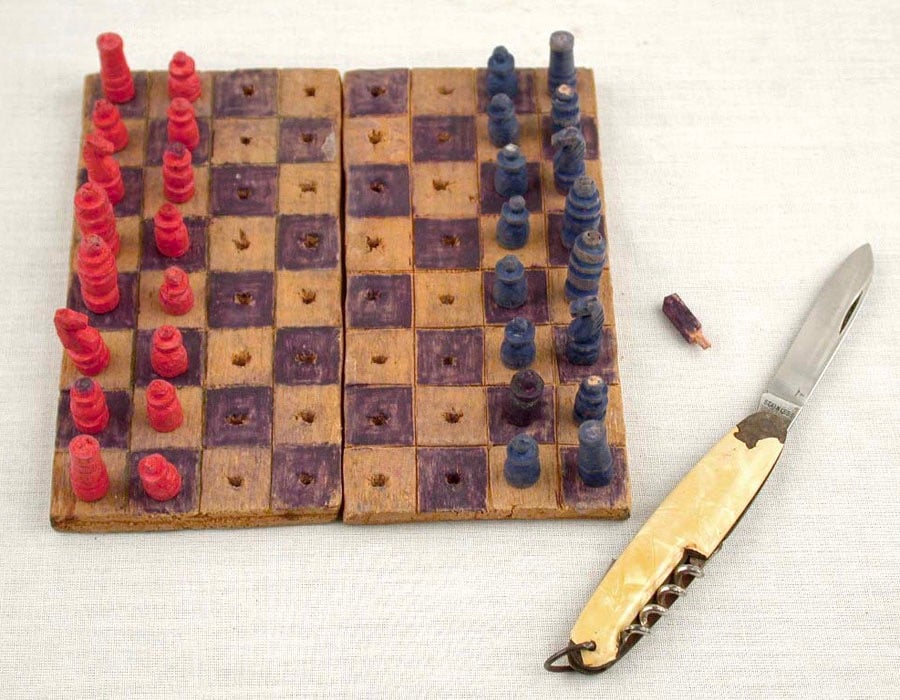


From Yad Vashem, Israel’s official memorial to the victims of the Holocaust, a collection of chess sets used by Jews during the Holocaust. Some of the sets predate the war while others were made and used in camps and in hiding.
Playing chess helped to alleviate the suffering of Jews and allowed them a few brief moments of relief from the hunger, the cold and the fear, temporarily easing their loneliness and sense of isolation.
Today is Apollo 11 day and as usual, you can watch the coverage here “live” as it happened 52 years ago. The TV will flicker to life at 4:10pm EDT for the landing and again at 10:51pm EDT for the moon walk.
After his short flight into space, Jeff Bezos thanked “every Amazon employee and every Amazon customer because you guys paid for all this”. Which is true, but usually you don’t say the quiet part loud?
This sounds interesting… Cultish: The Language of Fanaticism is a book about “how cultish groups from Jonestown and Scientology to SoulCycle and social media gurus use language as the ultimate form of power.”
Gil Scott-Heron: Whitey on the Moon
Inspired by the Apollo 11 moon landing, musician & poet Gil Scott-Heron wrote a spoken word poem called Whitey on the Moon. You can hear him recite it in the video above; here are the first few lines:
A rat done bit my sister Nell.
(with Whitey on the moon)
Her face and arms began to swell.
(and Whitey’s on the moon)
I can’t pay no doctor bill.
(but Whitey’s on the moon)
Ten years from now I’ll be paying still.
(while Whitey’s on the moon)
Back in 2011, shortly after Scott-Heron’s death, Alexis Madrigal wrote a short appreciation of the poem:
Let me just say that his track, “Whitey on the Moon,” changed the way I thought about the space race forever. It anchored the flight into the heavens, tethering it to the persistence of racial inequality, and pulling it out of the abstract, universal realm in which we like to place our technical achievements. Though I still think the hunger for the technological sublime crosses racial boundaries, it destabilized the ease with which people could use “our” in that kind of sentence. To which America went the glory of the moon landing? And what did it cost our nation to put whitey on the moon?
Apollo 11’s Lunar Module Might Still Be Orbiting the Moon
After Neil Armstrong and Buzz Aldrin landed on the Moon 52 years ago today in the Lunar Module (aka Eagle), they rode the ascent stage of the LM back to rendezvous with Michael Collins in the Command Module (aka Columbia). After docking, Eagle was jettisoned and the three astronauts returned to Earth in Columbia. It was presumed that Eagle orbited the Moon until eventually crashing into the surface, but a recent analysis shows that the spacecraft may have entered a stable orbit and is still circling the Moon decades after the end of the mission, a priceless artifact of an historic achievement.
Most spacecraft in lunar orbit suffer from instability in their orbits due to the ‘lumpy’ nature of the lunar gravity which tends to cause the orbits to eventually get so elliptical that they hit the moon.
However, an amateur space fan wanted to narrow down the possible impact location and used orbit modelling software to propagate the orbit forwards in time until it hit the moon. He was surprised to find that it didn’t hit the moon, and remained in a stable orbit for decades, this suggests that the Eagle may still be orbiting the moon over 5 decades after being left there.
The paper detailing the analysis suggests that if Eagle has survived, it should be detectable by radar.
Swimming Tentacled Droplets
Well, this is really quite odd. A group of scientists discovered that if they cool ordinary oily droplets floating in water down to around 2-8°C, they change shape, grow tentacles, and propel themselves around like tiny little sci-fi creatures.
Some of the particles’ facets grow while other shrink, producing a variety of geometrical forms such as kites, isosceles triangles and spiked tetrahedra. Then, from some of the sharp corners emerge tentacle-like strands, as if being extruded from a nozzle. As they grow, the strands bend into undulating shapes — and the droplets start to swim, propelled through the fluid by the tentacles’ extension.
Oh, nostalgia! This site has Print Shop running in an Apple II emulator and it outputs a PDF of your creation when you print.
Anti-Social Media
Roxane Gay on Why People Are So Awful Online:
Something fundamental has changed since then. I don’t enjoy most social media anymore. I’ve felt this way for a while, but I’m loath to admit it.
Increasingly, I’ve felt that online engagement is fueled by the hopelessness many people feel when we consider the state of the world and the challenges we deal with in our day-to-day lives. Online spaces offer the hopeful fiction of a tangible cause and effect — an injustice answered by an immediate consequence. On Twitter, we can wield a small measure of power, avenge wrongs, punish villains, exalt the pure of heart.
The Handshake of Generations
This reading of an excerpt of Andri Snær Magnason’s On Time and Water is a beautiful illustration of the idea of the Great Span.
Imagine that, 262 years. That’s the length of time you connect across. You’ll know the people who span this time. Your time is the time of the people you know and love, the time that molds you, and your time is the time of the people you will know and love, the time that you will shape. You can touch 262 years with your bare hands. Your great grandma taught you, you will teach your great granddaughter, you can have a direct impact on the future right up to the year 2186. Imagine that.
(via @robertsharp59)
“Cat Person” and Me. “Kristen Roupenian’s viral story draws specific details from my own life. I’ve spent the years since it published wondering: How did she know?”
Hilma af Klint, the Life of an Artist
On his Art History School YouTube channel, Paul Priestley gives a short but thorough overview of the life and work of pioneering abstract artist Hilma af Klint.
Hilma af Klint shared an interest in the spiritual with the other pioneers of abstract art including Wassily Kandinsky, Kazimir Malevich, and Piet Mondrian. And like Hilma af Klint many were drawn to Theosophy, which opened a route towards a new world of spiritual reality, rather than merely depicting visual impressions of the world around them.
Had she not kept her abstract work secret she would surely have held the accolade of producing the world’s first abstract paintings. Instead, Kandinsky’s paintings of 1911 would, until recently, come to be recognised as the first abstract works of art.
(via open culture)
Robots in Italy “with an artistic sensitivity” are carving marble sculptures commissioned by artists around the world. “We don’t need another Michelangelo. We already had one.”
NASA recently corrected a fault on the Hubble by switching to the backup hardware. The space telescope is fully operational again and will continue its incredibly productive 31-year mission.
The forthcoming new cookbook from Kenji Lopez-Alt is called The Wok, a book about “the most versatile pan in the kitchen”. A must-buy for me; anytime I’m looking for a recipe for something to cook, I google “kenji [name of dish]”.
A study using fitness tracker data shows that people w/ Covid often had elevated heart rates for months. “It took 79 days, on average, for their resting heart rates to return to normal, compared with just four days for those in the non-Covid group.”
Magically Turning Into Random Objects. This is really well done.
An AI Bourdain Speaks From the Grave
I have been trying not to read too much about Morgan Neville’s documentary Roadrunner: A Film About Anthony Bourdain before I have had a chance to watch it, but the few things I have read about it have given me some pause. From Helen Rosner’s piece about the film drawn from an interview with Neville:
There is a moment at the end of the film’s second act when the artist David Choe, a friend of Bourdain’s, is reading aloud an e-mail Bourdain had sent him: “Dude, this is a crazy thing to ask, but I’m curious” Choe begins reading, and then the voice fades into Bourdain’s own: “…and my life is sort of shit now. You are successful, and I am successful, and I’m wondering: Are you happy?” I asked Neville how on earth he’d found an audio recording of Bourdain reading his own e-mail. Throughout the film, Neville and his team used stitched-together clips of Bourdain’s narration pulled from TV, radio, podcasts, and audiobooks. “But there were three quotes there I wanted his voice for that there were no recordings of,” Neville explained. So he got in touch with a software company, gave it about a dozen hours of recordings, and, he said, “I created an A.I. model of his voice.” In a world of computer simulations and deepfakes, a dead man’s voice speaking his own words of despair is hardly the most dystopian application of the technology. But the seamlessness of the effect is eerie. “If you watch the film, other than that line you mentioned, you probably don’t know what the other lines are that were spoken by the A.I., and you’re not going to know,” Neville said. “We can have a documentary-ethics panel about it later.”
Per this GQ story, Neville got permission from Bourdain’s estate:
We fed more than ten hours of Tony’s voice into an AI model. The bigger the quantity, the better the result. We worked with four companies before settling on the best. We also had to figure out the best tone of Tony’s voice: His speaking voice versus his “narrator” voice, which itself changed dramatically of over the years. The narrator voice got very performative and sing-songy in the No Reservation years. I checked, you know, with his widow and his literary executor, just to make sure people were cool with that. And they were like, Tony would have been cool with that. I wasn’t putting words into his mouth. I was just trying to make them come alive.
As a post hoc ethics panel of one, I’m gonna say this doesn’t appeal to me, but I bet this sort of thing becomes common practice in the years to come, much like Errol Morris’s use of reenactment in The Thin Blue Line. A longer and more nuanced treatment of the issue can be found in Justin Hendrix’s interview of Sam Gregory, who is an “expert on synthetic media and ethics”.
There’s a set of norms that people are grappling with in regard to this statement from the director of the Bourdain documentary. They’re asking questions around consent, right? Who consents to someone taking your voice and using it? In this case, the voiceover of a private email. And what if that was something that, if the person was alive, they might not have wanted. You’ve seen that commentary online, and people saying, “This is the last thing Anthony Bourdain would have wanted for someone to do this with his voice.” So the consent issue is one of the things that is bubbling here. The second is a disclosure issue, which is, when do you know that something’s been manipulated? And again, here in this example, the director is saying, I didn’t tell people that I had created this voice saying the words and I perhaps would have not told people unless it had come up in the interview. So these are bubbling away here, these issues of consent and disclosure.
Update: From Anthony’s ex-wife Ottavia Bourdain about the statement that “Tony would have been cool with that”:
I certainly was NOT the one who said Tony would have been cool with that.
(via @drawnonglass)
Carl Sagan in 1978: Star Wars Is Too White
During a Tonight Show appearance in 1978, Johnny Carson asked Carl Sagan about the scientific accuracy of Star Wars. Sagan replied:
The 11-year-old in me loved them but they could have made a better effort to to do things right. A lot of different aspects of things — Star Wars starts out saying it’s on some other galaxy and then you see there’s people. Starting in scene one there’s a problem, because human beings are the result of a unique evolutionary sequence based upon so many individually unlikely random events on the Earth.
In fact, I think most evolutionary biologists would agree that if you started the Earth out again and just let those random factors operate you might wind up with beings that are as smart as us and as ethical and artistic and all the rest, but they would not be human beings. That’s for the Earth. So in another planet, different environment, very unlikely to have a human being. It’s extremely unlikely that there would be creatures as similar to us as as the dominant ones in Star Wars.
And a whole bunch of other things: they’re all white. The skin of all the humans in Star Wars, oddly enough, is like this. And not even the other colors represented on the Earth at present, much less greens and blues and purples and oranges.
Carson pushes back slightly at this point: “They did have the scene of Star Wars with a lot of strange characters.” But Sagan persists:
Yeah, but none of them seem to be in charge of the galaxy. Everybody in charge of the galaxy seemed to look like us. And I thought it was a large amount of human chauvinism.
Sagan also complained about Han Solo’s boast of doing the Kessel Run in less than 12 parsecs. According to the script, this was an “obvious” lie on Han’s part to make his ship sound impressive, so Sagan missed that. But then, post-Lucas, the Kessel Run was explained in Solo: A Star Wars Story as a distance shortcut and not an elapsed completion time, so…. (via digg)
The Perfect Head Stabilization of a Hunting Red-Tailed Hawk
I posted about the 2021 Audubon Photography Awards earlier today, but I wanted to highlight Bill Bryant’s award-winning clip of a red-tailed hawk. The hawk is hunting, floating on the wind searching for small prey, its head perfectly still while its body stabilizes around it. I could watch this clip on repeat for the rest of the day…so cool!
This is not just a thing that hawks do — see also This Owl Will Not Move His Head and The Eerie Stillness of Chicken Heads. Birds: nature’s steadycams.
Winners of the 2021 Audubon Photography Awards

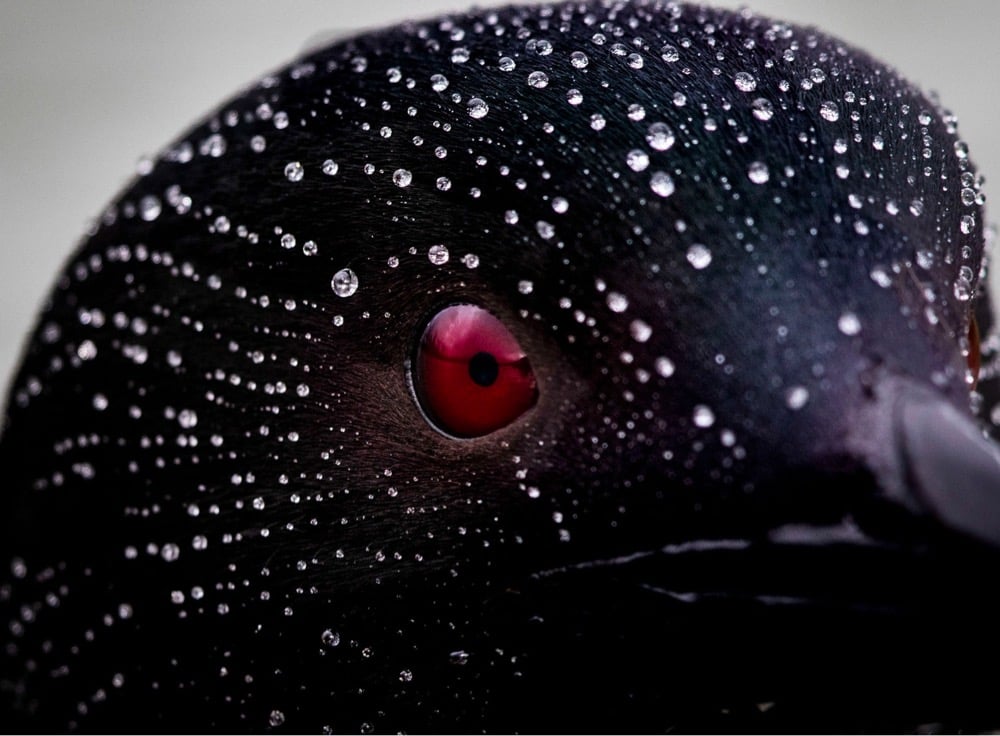

The National Audubon Society has announced the winners of the their photography competition for 2021. They also selected a top 100 from the rest of the submissions to complement the winners. The photos above are by Jerry am Ende, Sue Dougherty, and Tim Timmis. (via in focus)
PJ Harvey & Bjork Cover (I Can’t Get No) Satisfaction
This cover of the Rolling Stones’ (I Can’t Get No) Satisfaction by PJ Harvey and Bjork at the 1994 Brit Awards is kind of amazing — I’d never seen this before. The duet is a slow burn, but it really gets there in the end. BTW, this was the same night that Elton John and RuPaul performed Don’t Go Breaking My Heart together. (via @brianmcc)
The Well-Tempered Traveler is a single serving site from Google (??) that shows year-round temperatures & precipitation levels for dozens of cities around the world.
“I Want You To Look Me In the Eye”
Filmmaker James Robinson has an eye condition he calls “whale eyes” that causes him to see differently than (and look differently to) most people. In this short film, he makes a plea to “normal” people for acceptance of his and others’ differences.
But his video is also an essay on seeing, in the deeper sense of the word — seeing and being seen, recognition and understanding, sensitivity and compassion, the stuff of meaningful human connection.
In a society that does a lousy job of accommodating the disabled, Mr. Robinson appeals for more acceptance of people who are commonly perceived as different or not normal.
“I don’t have a problem with the way that I see,” he says. “My only problem is with the way that I’m seen.”
Unread Messages by Sally Rooney
There’s new short fiction from Sally Rooney in the New Yorker: Unread Messages.
For the rest of the afternoon in the office, the woman worked on the same text-editing interface, moving apostrophes and deleting commas. After closing one file and before opening another, she routinely checked her social-media feeds. Her expression, her posture, did not vary depending on the information she encountered there: a news report about a horrific natural disaster, a photograph of someone’s beloved pet, a female journalist speaking out about death threats, a recondite joke requiring familiarity with several other previous Internet jokes in order to be even vaguely comprehensible, a passionate condemnation of white supremacy, or a promoted tweet advertising a health supplement for expectant mothers. Nothing changed in her outward relationship to the world that would allow an observer to determine what she felt about what she saw. Then, after some length of time, with no apparent trigger, she closed the browser window and reopened the text editor. Occasionally one of her colleagues would interject with a work-related question and she would answer, or someone would share a funny anecdote with the office and they would all laugh, but mostly the work continued quietly.
Per an interview with Rooney, the piece is excerpted from her next novel, Beautiful World, Where Are You, due out in September and eagerly anticipated in this household.
America’s Abstract Freedom
This is quite a paragraph from David Bentley Hart’s Three Cheers for Socialism in Commonweal:
Americans are, of course, the most thoroughly and passively indoctrinated people on earth. They know next to nothing as a rule about their own history, or the histories of other nations, or the histories of the various social movements that have risen and fallen in the past, and they certainly know little or nothing of the complexities and contradictions comprised within words like “socialism” and “capitalism.” Chiefly, what they have been trained not to know or even suspect is that, in many ways, they enjoy far fewer freedoms, and suffer under a more intrusive centralized state, than do the citizens of countries with more vigorous social-democratic institutions. This is at once the most comic and most tragic aspect of the excitable alarm that talk of social democracy or democratic socialism can elicit on these shores. An enormous number of Americans have been persuaded to believe that they are freer in the abstract than, say, Germans or Danes precisely because they possess far fewer freedoms in the concrete. They are far more vulnerable to medical and financial crisis, far more likely to receive inadequate health coverage, far more prone to irreparable insolvency, far more unprotected against predatory creditors, far more subject to income inequality, and so forth, while effectively paying more in tax (when one figures in federal, state, local, and sales taxes, and then compounds those by all the expenditures that in this country, as almost nowhere else, their taxes do not cover). One might think that a people who once rebelled against the mightiest empire on earth on the principle of no taxation without representation would not meekly accept taxation without adequate government services. But we accept what we have become used to, I suppose. Even so, one has to ask, what state apparatus in the “free” world could be more powerful and tyrannical than the one that taxes its citizens while providing no substantial civic benefits in return, solely in order to enrich a piratically overinflated military-industrial complex and to ease the tax burdens of the immensely wealthy?
I mean, when you put it like that…
Visualization of How Fast a Ball Drops on Various Solar System Bodies
This is an animation of how quickly an object falls 1 km to the surfaces of solar system objects like the Earth, Sun, Ceres, Jupiter, the Moon, and Pluto. For instance, it takes 14.3 seconds to cover that distance on Earth and 13.8 seconds on Saturn.
It might be surprising to see large planets have a pull comparable to smaller ones at the surface, for example Uranus pulls the ball down slower than at Earth! Why? Because the low average density of Uranus puts the surface far away from the majority of the mass. Similarly, Mars is nearly twice the mass of Mercury, but you can see the surface gravity is actually the same… this indicates that Mercury is much denser than Mars.
(via @thekidshouldsee)
Watch 13x female world champion arm wrestler Irina Gladkaya take on all muscle-bound comers at Muscle Beach Miami. These matchups are all over in a comically short amount of time.
A NASA study is predicting a surge of coastal flooding starting in the 2030s. The cause is rising sea levels due to climate change amplified by a wobble in the Moon’s orbit.
A Drone’s View of the Great Pyramid of Giza


Alexander Ladanivskyy recently photographed the Great Pyramid at Giza from an unusual vantage point: straight overhead with a drone. The final photo in the series is so close-up that you can see the graffiti on the stones at the tip of the pyramid. (via colossal)
Instant new favorite weather app: Weather Strip. As @craigmod notes, the weather timeline is the best weather visualization around.
John Oliver Loves Octopuses
John Oliver’s HBO show is on hiatus for the summer, but he really wanted you to know some facts about the many species of amazing octopuses out there (and why it is “octopuses” and not “octopi”).
See also My Octopus Teacher and A Dreaming Octopus Changes Color.
Succession Season 3 Teaser Trailer
Ok I know you’ve probably seen the teaser trailer for season 3 of Succession by now but I was away and missed it so we’re all going to watch it together mmm’kay? New season starts “this fall”, whatever that means. I guess that’s enough time for a rewatch of the first two seasons?
Instagram Has Become SkyMall. “These days when I open up the app, every ad customized for me is some decidedly loopy gewgaw.”
Half a Life in 2 Minutes
For more than 21 years, Noah Kalina has taken a photograph of himself. Periodically, he makes video compilations of the photos — you’ve probably seen them here or elsewhere. For his latest video, he’s collaborated with Michael Notter (visuals) and Paul O’Mara (sound) on a video called 7777 Days.
In a first step, Michael used the machine learning library dlib (http://dlib.net/) and some custom Python code to detected in each of Noah’s photos 5 face landmarks (i.e. both eyes, the nose and the two corners of the mouth). These landmarks were then used to align the faces in all photos, so that the eyes and corner of the mouth were horizontally oriented and always an equal distance apart. After that, some small image intensity correction were applied to make very dark images a bit brighter and very bright ones a bit darker. This was followed by an upscaling of all images (where needed) to a 4K resolution.
The result is a 2-minute video (reminiscent of Jason Salavon’s work) that spans half of Kalina’s life — in the video he ages 2 months every second and 10 years a minute.
Update: Kalina and Notter explain how this video came about and how it was made.
Retro Modern Movie Posters
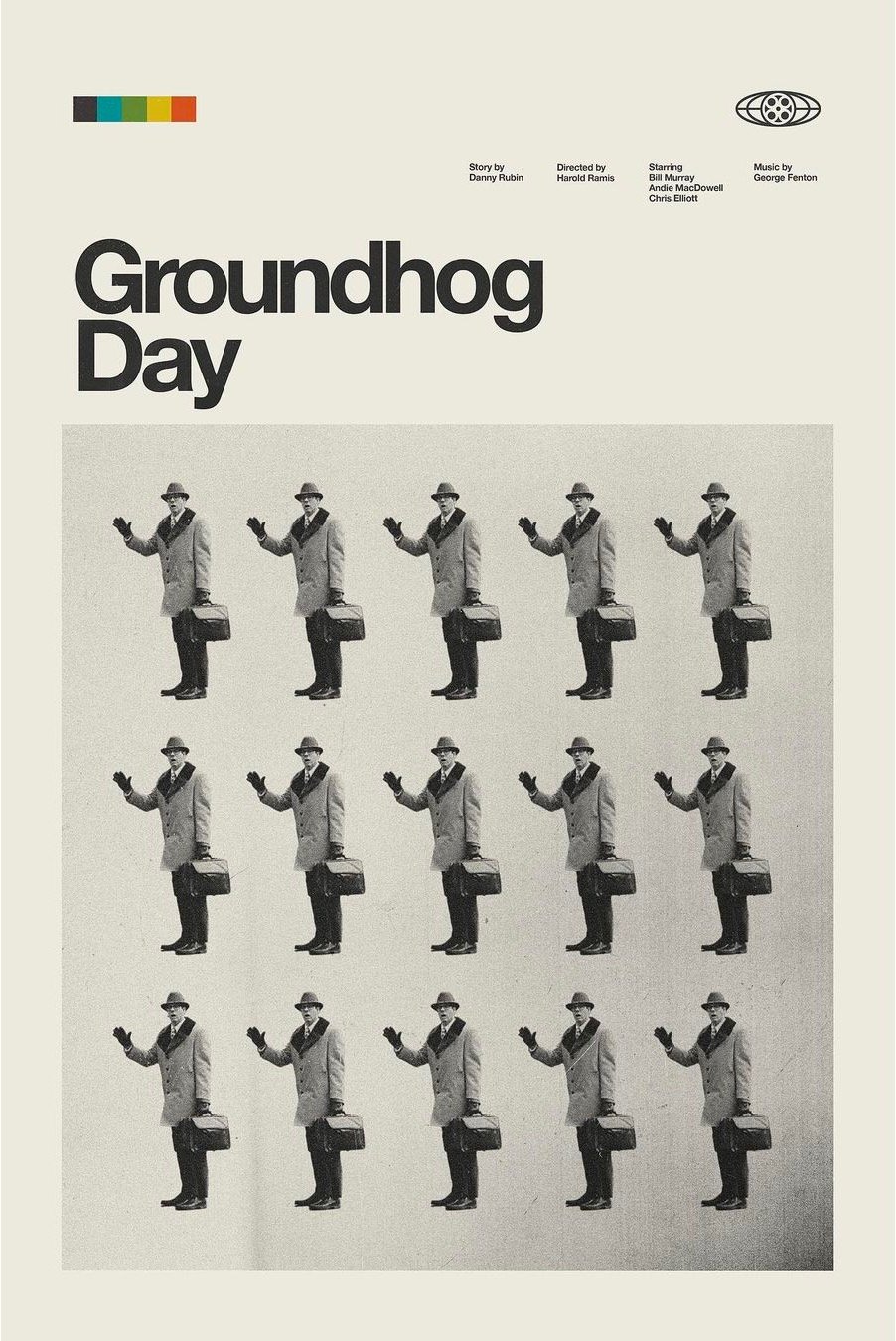
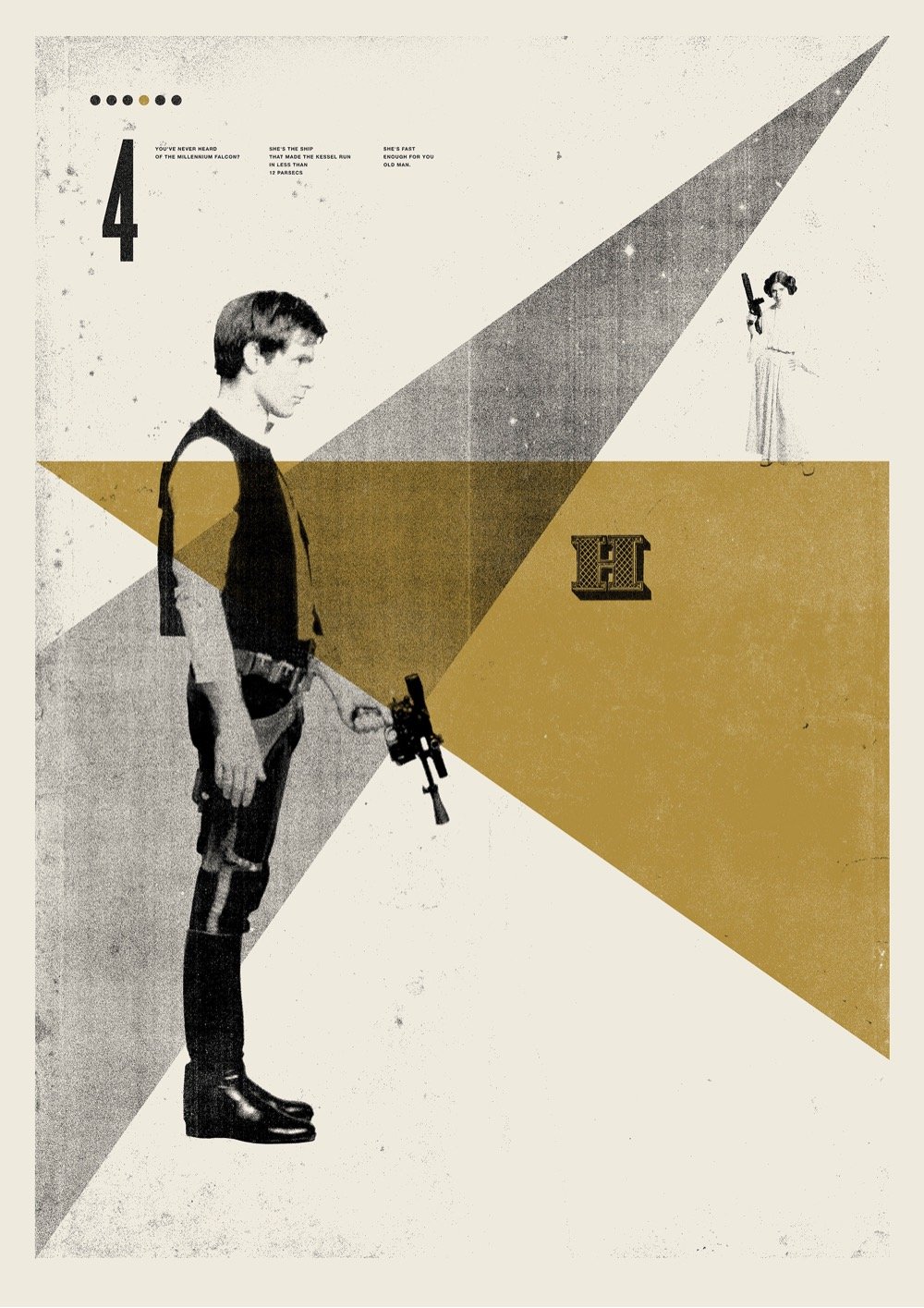

Check out these retro modern movie posters from Patrick Concepcion; the Groundhog Day one is simple perfection. You can check out Concepcion’s work on his website and Instagram or buy prints on Etsy.
Oh, and you really can clean your cast iron pan with dish soap. No need to be so precious about it…
The Myth of the Cast Iron Pan. “Having sprung from the core of the earth, it will die a tragic death if exposed to the tiniest soap bubble. The mortal gently cleanses the cast-iron with water, like a doting river nymph.”
Mr. @glennf is hosting the Kottke Ride Home podcast this week while @jackisnotabird is away on vacation. Listen in! (Also, Jack and I finally met in person recently – so good to chat w/ him about the evolution of social media & many other things.)
Thom Yorke’s 2021 Remix of Creep
In collaboration with Jun Takahashi, Thom Yorke has released a “Very 2021” remix of his band’s iconic Creep. Slow and reverby, the singer’s perhaps-least-favorite Radiohead song takes on new life for this (second?) oddest of years. On first listen, I like but maybe don’t love this version, but some of the YT comments are worth reading:
Can’t believe Thom Yorke finally collaborated with Radiohead. Two of my favorite artists making a song together
Thom has went so far into artistic discovery he looped back on himself. It’s like post-post-irony, but musically
I can’t believe Thom made a doomer wave version of his own fucking song
Thom nailed this one, he sounds just like the originals singer!
You can find the song on a variety of platforms.
The History and Future of Electric Car Design

Car and Driver has a good article that both assesses the brief history of electric car design and looks at where things might be headed going forward, as designers break free of some early conceptions about what a car (or what a specifically electric car) needed to look like. Some highlights:
Many early EV ventures used existing platforms and arranged electric powertrains to fit where gas engines and transmissions had previously resided. Even Tesla’s first attempt was a revamped Lotus Elise without its 1.8-liter inline-four. Working on a nondedicated, or “nonnative,” electric platform limited designers’ options for positioning the battery and motor. Automakers often stacked batteries under the rear seat—which is why early EVs sometimes offered less legroom or cargo space than their gas counterparts—and put the motor assemblies under the hood. Even the Nissan Leaf, which packages an underfloor battery in a dedicated EV platform, still follows the old philosophy of carrying a motor where an engine normally goes. Aesthetically, too, the early electrics couldn’t break away from distinct grille shells and large air vents…
“We have the opportunity to give the car a totally new kind of proportion,” says Steffen Köhl, Mercedes-Benz director of advanced exterior design. Köhl worked on the EQS, the first car on Mercedes’s new Electric Vehicle Architecture (EVA). The EQS is a luxury sedan with a long wheelbase, a sweeping bridge of a roofline, and a large, screen-filled cabin. Think of it as the S-class of EVs. The underpinnings of an EV allow for bigger interiors in smaller vehicles, he says. It can be “cabin-forward, with short overhangs in front and rear. Since the battery is flat ground, we can try a new kind of interior—smooth panels, the center console floating. There are no more ups and downs between the seats.”
For my part, even this broader vision is still too focused on coupes, sedans, SUVs, and other “traditional” four-to-five seat cars. There’s a brief discussion of the new F-150 electric pickup truck, but very little about buses or single-rider ATV designs. A lot of looks at the “skateboard” chassis popularized by Tesla, not enough actual skateboards. If we’re going to cast a broader view, let’s cast it as broad as we can.
Just How Badly Do You Want That Replacement Atari Console Part?

Vice has a sometimes less-than-flattering profile of Best Electronics’ Bradley Koda, a persnickety entrepreneur who has an unrivaled catalog of old-school Atari console parts and a reputation for shutting out buyers who get impatient with doing things his way:
Among Atari fans, Best is almost as famous for ignoring and blacklisting badly behaved customers as it is for selling Atari parts. A first attempt to buy from Best Electronics is a sink-or-swim proposition: learn the rules, or accept your fate…
Koda is a monopolist, of a sort, but he’s no Jeff Bezos. Best Electronics has no virtual shopping cart, or any other Amazon-esque conveniences. The store’s website looks the same as it has since the early 2000s: it’s a lengthy, multicoloured text scroll, as if Jack Kerouac quit the novel-writing business (but not the benzedrine) and started typing about Atari…
Anyone who can’t figure out this system risks being deemed a time-waster. In emails to customers, Koda often laments his busy schedule, and he seems to take distractions personally. He would rather lose a sale than suffer someone who hasn’t learned the rules.
Best has been in business more than 25 years. Its equipment is mostly unused Atari originals, not salvaged parts. The company’s catalog was printed more than 20 years ago (and is available only in print); corrections (including changes in price) are only available online. His customers both love him and fear him.
In short, it’s a throwback to old-school nerd retail, the kind lampooned by The Simpsons’ Comic Book Guy. What, did you think finding first-rate replacement parts for your forty-year old video game machine would be like buying AA batteries?
Cuttlefish don’t live a long time like corvids or have highly social lives like chimpanzees. They don’t even perform magic tricks squeezing into caves or holes like octopi. But they’re smart. How do they do it?
On Zaila Avant-garde, the New National Spelling Bee Champ

Along with a liveblog of the last few rounds of this year’s Scripps National Spelling Bee, The New York Times has an excellent profile of its champion, 14 year-old Zaila Avant-garde from New Orleans, Louisiana. (One fun fact: Zaila’s last name is an homage by her father to John Coltrane.)
Zaila, who just finished eighth grade in her hometown, Harvey, La., showed a prowess for spelling at 10, when her father, who had been watching finals of the Scripps National Spelling Bee on ESPN, asked her how to spell the winning word: marocain.
Zaila spelled it perfectly. Then he asked her to spell the winning words going back to 1999. She spelled nearly all of them correctly and was able to tell him the books where she had seen them.
“He was a bit surprised by that,” Zaila said in an interview before the finals.
This is a heck of a party trick that kids with hyperlexia can do; I can do it, and unsurprisingly, hyperlexia (and possibly a photographic memory) is an advantage for competitive spelling.
But Zaila’s talents don’t end there:
A gifted basketball player, she set three Guinness world records for the most basketballs dribbled simultaneously (six basketballs for 30 seconds); the most basketballs bounces (307 bounces in 30 seconds); and the most bounce juggles in one minute (255 using four basketballs). With her victory on Thursday, she also became the first winner from Louisiana.
In 2018, she appeared in a Steph Curry commercial that showcased her skills. She also learned how to speed read and figured out that she could divide five-digit numbers by two-digit numbers in her head, a skill she said she had a hard time explaining.
“It’s like asking a millipede how they walk with all those legs,” said Zaila, who has three younger brothers.
[I can… kinda do this? (I can’t really do this very well. The point is, all of this is very impressive!)]
Zaila just graduated eighth grade, and she’s the first African-American spelling champ in the bee’s history. She’s got skills and drive to spare.
Brandy Alexander

This is a somewhat sentimental post for me: years ago, I had dinner with Jason at a restaurant in Manhattan (I forget which one) and ordered a brandy alexander. It turned out that the bartender didn’t know how to make one, so I tried my best to explain — in the end, I wound up with a white Russian instead.
But! A brandy alexander is a dang nice drink, and everyone should know how to make one. Even the internet turns up some pretty bizarre recipes that morph into that white Russian I had back in 2016. My favorite (of the ones that I remember) was probably twenty-one years ago, when I was a college student on vacation in Paris, ordered at a piano bar where tourists and locals alike belted out American showtunes. I’ll never be that young again.
But! It’s Thursday and it’s 5:30 on the east coast, so there’s no reason (except, like me, not having creme de cacao on hand) you can’t make yourself one of these so you can feel that young yourself.
This recipe largely follows the one at liquor.com, which offers a solid history for the cocktail (it used to be made with gin? okay, weird; most cocktails used to be made with brandy, not the other way around) and also feels the least objectionable:
Ingredients:
- 1 1/2 ounces cognac
- 1 ounce dark creme de cacao
- 1 ounce cream
- Garnish: grated nutmeg
Steps:
- Add cognac, dark creme de cacao and cream into a shaker with ice and shake until well-chilled.
- Strain into a chilled cocktail glass or a coupe glass.
- Garnish with freshly grated nutmeg.
Notes:
- Cognac is brandy, but cognac is fancy brandy; other brandies can be good but cognac is pretty much always good. So why not use cognac?
- I like a coupe glass; cocktail glasses look pretty but are a good way to spill your drink.
- You could go equal parts cognac, creme de cacao, and cream, but why? It’s better with more liquor in it.
- Don’t add more ice, even if you serve it in a rocks glass. Up is the way to go here.
- You can get very dessert-y with brandy alexanders (whipped cream, ice cream, shaved chocolate, etc.), but at heart the thing is a cocktail, so treat it like a cocktail.
Postscript:
“Brandy Alexander” is a fun song by Feist (and songwriter Ron Sexsmith). It also (somewhat on the sly) references a famous 1974 incident where John Lennon, drunk on the cocktail with Harry Nilsson, got thrown out of the Troubadour during Lennon’s “lost weekend” in Los Angeles. You don’t have to like any of the music to like the drink, or vice versa.
All Songbirds Evolved In Australia (And They Love The Sweet Stuff)
The Atlantic’s Ed Yong is one of our great biology writers. He recently won a Pulitzer for his coverage of the COVID-19 pandemic, but it’s equally illuminating and much more fun to read him write about tapeworms or some other more benign form of life.
In this case, it’s about songbirds, which have two unusual things in common besides their love of song: they all evolved to detect and eat sugar in the form of sap and nectar [and did so in a way different from hummingbirds, who also love the sweet stuff], and they all did this in Australia, and from there spread out all over the world.
Songbirds probably evolved sweet perception about 30 million years ago, when Australia was much wetter. As the climate dried, the soils became poorer and the eucalyptus trees expanded. The forests abounded with new sources of sugar such as manna, which the songbirds were already primed to find and exploit. Perhaps the extra energy from these abundant calories allowed them to migrate over long distances and travel to other continents. Perhaps they could thrive in their new homes by finding flowers that were already baiting insects with nectar. “They are the most successful group of birds,” Eisthen told me. “You have to wonder how much of their success is due to this hidden talent, which allows them to invade new niches and feed on food sources that other animals are not exploiting.” …
Meanwhile, Sushma Reddy, an ornithologist at the University of Minnesota, points out that hummingbirds, songbirds, and parrots, three groups of birds with lots of nectar-eating species, “are also the same lineages that have convergently evolved vocal learning”—the ability to make new songs and sounds after listening to other individuals. Could these traits be related? Perhaps there’s a hidden connection between the sugary riches of Australia’s forests and the beautiful tunes that fill the air of every continent—between sweetness of palate and sweetness of voice.
Side note: Ed mentions in a parenthetical here that “fans of the board game Wingspan and its Oceania expansion will be familiar with the importance of nectar to Australian birds.” I, in fact, was not familiar with the board game Wingspan or any expansions thereof, so I looked it up:
You are bird enthusiasts—researchers, bird watchers, ornithologists, and collectors—seeking to discover and attract the best birds to your network of wildlife preserves. Each bird extends a chain of powerful combinations in one of your habitats (actions). These habitats focus on several key aspects of growth:
- Gain food tokens via custom dice in a birdfeeder dice tower
- Lay eggs using egg miniatures in a variety of colors
- Draw from hundreds of unique bird cards and play them
The winner is the player with the most points after 4 rounds.
Also, apparently it’s a card-based game, but is also available for computers via Steam. The more you know!
New Labour and the End of the Welfare State for Artists
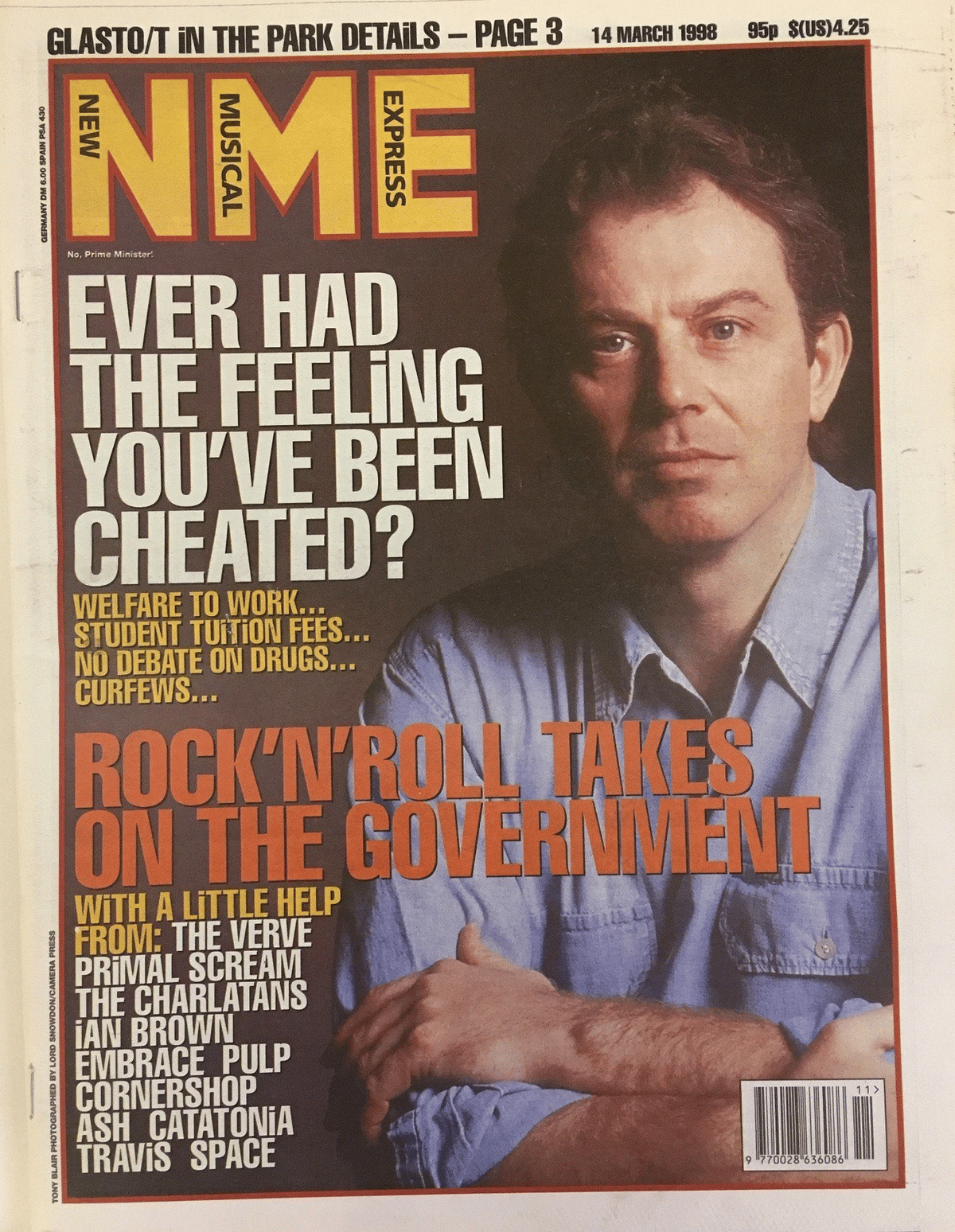
Most US-centric attempts to imagine a future where artists and humanists’ work is better supported by the government hearkens back to the Works Progress Administration (later, the Work Projects Administration) of the late 1930s and early 1940s. There are, however, more recent models outside the US worth emulating, although their stories often don’t end so well as the WPA’s appears to.
Until the New Labour movement overhauled the British welfare system in the late 1990s, aspiring musicians were often able to exploit loopholes in the welfare system to support their own work. There’s some irony in the fact that the more progressive of the two parties winning control of government effectively ended some of the more progressive social programs that thrived under the conservative regime, although that’s not limited to the UK.
In a recent blog post, David Lance Callahan, who’s writing a book about the intersection of music and the welfare state in the UK, looked at this moment in the late 1990s, when the UK’s music scene went from underground to overground, and the welfare state fell apart:
However, despite these ideological ogres [the Tories] being in power throughout the 1980s and most of the ’90s, their attempts to massage the massive unemployment figures their policies created inadvertently led to an expansion of the opportunities available to find state support for one’s creative endeavours. The ability to get off the dole for a year as part of the Enterprise Allowance Scheme was particularly welcome - if you could get £1,000 put into your bank account for the one day the Department of Social Security demanded to see it there. Often the money was returned to a generous friend or relative the very next day, but the scheme meant that a budding or struggling musician (or manager, record label or sound engineer) could start their own business and be mostly left alone to write, record, tour and promote the results. If you could show some financial or business progress or actual success over that year, then all the better.
This was as true of bands in the ’90s as it was in the previous couple of decades. Very few could have existed without the time and space afforded by signing on and the skin-of-the-teeth security provided by cheap (or free) housing and supplementary benefit - or a non-returnable student grant for art school or uni. Things could only get better with Labour in charge, right?
It feels like on some days it’s easier to imagine how much simpler it could be with debt forgiveness, free or inexpensive higher education, and a universal basic income, and on other days all one can do is imagine how any of those programs, grossly implemented, could be used to tear the existing social safety net (sparse as it is) apart. We have good reason to fear such things! In the 1990s, they happened! It wasn’t a hundred years ago; we remember it ourselves.
Bonus: Callahan’s post includes many clippings of artists from some of your favorite 90s UK bands (Pulp, Belle and Sebastian, Primal Scream, and more) somewhat ambivalently reflecting on their time on welfare and how it enabled them to become successful musicians.
(Via Bethany Klein)
Who’s Gotten Their Copyright Back?
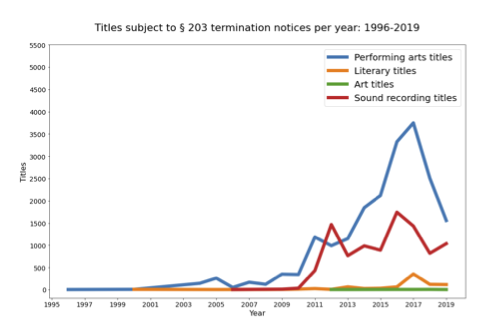
Currently in the United States, an author’s copyright expires 70 years after the author’s death or 95 years after its first publication. But what about when an author of a work grants their exclusive copyright to a publisher or some other partnership? In that case, an author can request that the work’s copyright revert to their sole ownership after 35 years.
It’s called reversion, and it doesn’t happen often, because it’s not automatic; there are legal hurdles to jump through to file copyright termination notices, meaning you need money, help, and strong motivation to make it happen. And in some famous cases (see virtually every famous superhero ever), if you’ve created something as a work for hire, copyright termination alone isn’t always going to get it done. But it does happen, and it’s interesting to see (and to measure, at scale) in just what cases it comes together.
That’s the subject of a new academic study by Joshua Yuvaraj, Rebecca Giblin, Daniel Russo-Batterham, and Genevieve Grant. The authors also created a complete dataset of copyright termination notices from 1978 to 2020 for other researchers to parse; their initial findings are summarized here by Cory Doctorow.
Few creators have managed to revert but the ones that have are fascinating. Stephen King is a leading reverter, as are George RR Martin, Nora Roberts and David Eddings. - successful authors who are able to claim back their works and seek new deals based on their track records.
A single YA author - Francine Pascal_ - accounts for nearly all the YA reversions, thanks to her reclaiming of all 305 of her Sweet Valley High novels (in kids’ books, Ann Martin attains another high-water mark for reverting the Baby-Sitters Club books).
But the most fascinating entry is funk titan George Clinton, who pursued his former manager Nene Montes for years, claiming he’d forged Clinton’s signature and defrauded him to steal the rights to most of Clinton’s prodigious and profitable catalog.
Thanks to reversion, Clinton was able to finally settle all question of title without expensive litigation - he simply reverted 1,413 works.
Other notable filers of termination notices include Philadelphia-based musical partners Gamble and Huff and Hall and Oates, and the heirs of Superman co-creator Jerry Siegel and playwright August Wilson. Another somewhat ironic entry is Pat Boone, who famously re-recorded many, many popular Black artists’ songs to cash in on segregated radio; Boone submitted 643 copyright termination notices for songs under his assigned copyright.
As the authors point out, there are limitations in the data set. Filing a copyright termination notice doesn’t mean that copyright automatically reverts back to the author; an author or their heirs might use the termination notice to successfully renegotiate their deal with the current licensee, or there may have been mistakes in their legal filings, or some other mishap.
Strangely, however, the authors note that while there are periodic spikes in copyright termination notice activity (for example, immediately after the statute was first passed in the 1970s), there’s currently a dip in termination requests under both sections of the copyright law that allows rights to be reverted. And the authors do not precisely whether it’s a periodic flux, or a long-term trend, or why either might be the case.
It’s Expensive To Be A Competitive Drag Queen

Drag has always been a world of aspirations and contradictions, playing not just on gender, but on race, power, wealth, and respectability. So in some sense, it’s not surprising that being a contestant on RuPaul’s Drag Race and its affiliated series is remarkably expensive:
“I spent more coming into this competition than I did as the down payment on my house,” Kameron says, her tone serious now.
“I spent more on this competition than I did on college,” Cracker replies solemnly, and a moment of silence falls over both queens.
Contestants estimate that the cost of all the outfits in a current season of the show is between $20,000 and $30,000. This is five to six times as much as the earlier, more low-budget seasons.
But perhaps this is a case of some well-bankrolled contestants getting overzealous, and others struggling to keep up? Not exactly:
During Episode 5’s critiques, judge Michelle Visage took issue with contestant Joe Black’s look from the week’s maxi challenge. Earlier in the episode, Joe had sung and danced his way through the Eurovision girl-group challenge wearing a pink knee-length dress with a high neck and puffy sleeves. “You came out wearing a finger wave wig, and something I probably could have bought off the rack at Primark, no joke,” Michelle says. In response, Joe stage-whispers, “Aiiitch and emmmmm,” and then laughs.
The music hits a dramatic note as the camera cuts to RuPaul, who looks… grim. “That outfit off the rack was a huge disappointment to me,” Ru says. “That’s what everyday people do, and you are a star. And this goes to all of you up here: If it is from H&M, you better glitter the fuck out of it, and make it something special. We’re looking for Great Britain’s next superstar. Don’t waste my time. I don’t want to see any fucking H&M.”
The harsh criticism of a downmarket dress didn’t look great coming from a world-famous drag queen who owns a 60,000-acre ranch in Wyoming. And it got worse. Joe Black had been eliminated in Episode 1, then unexpectedly brought back to replace a different contestant after the show’s mid-season seven-month COVID hiatus, but had been forced to sell all of his costumes during lockdown. (The pandemic decimated live entertainment, including drag performances.) “I had sold them because I needed the money to live,” Joe said. “So not only did I need to find the money, but I also needed to get the costumes again.”
But there is also a sense in which drag and ball culture is only newly big business (with Drag Race as the showcase):
The idea of investing a ton of money in a drag career and having it pay off is a relatively modern one. According to Tom Fitzgerald and Lorenzo Marquez, authors of Legendary Children: The First Decade of RuPaul’s Drag Race and the Last Century of Queer Life, performers simply didn’t have access to many venues for most of drag’s history—largely because cross-dressing was illegal throughout the United States until the 1970s. Most drag performers never left their community, and while their local gigs may have been emotionally rewarding, they weren’t particularly lucrative.
Social and financial marginalization forced drag artists to be creative. “Up until the 80s and the 90s, drag queens essentially dressed in vintage clothing,” Fitzgerald told VICE. “Trans women and queer men couldn’t walk into a department store and buy dresses. It was easier and safer to go look for a size 13 pump in a used store than it was to go into the ladies section. The underground aspect of drag defined the aesthetic for a very long time.”
Even in earlier seasons of Drag Race, when contestants were competing for an amount of money that was unprecedented in the drag world, the runways had nowhere near the scale that they do in more recent seasons. “When Drag Race first started, they were literally coming in off the street to do this TV show,” Fitzgerald said. “And now it’s 13 years later, it’s won all of these Emmys, it’s HD, it’s got superstar guest stars. The stakes are just higher.”
From Text Adventures to Modern Interactive Fiction
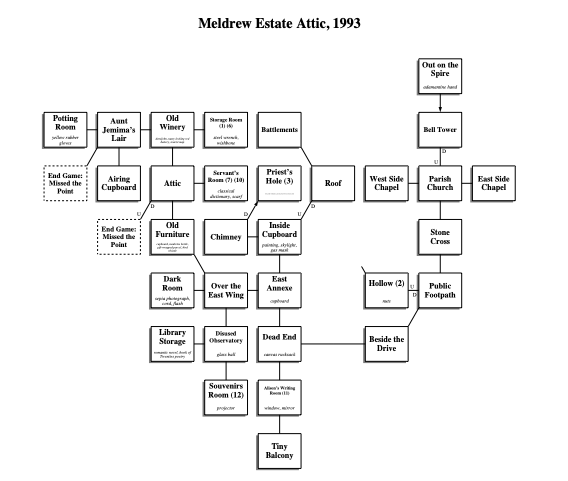
50 Years of Text Games by Aaron Reed is a favorite newsletter of mine. (It’s a hard newsletter to read in your email right away, but a rewarding one to pile up and save.) It specializes in in-depth explorations, typically at a single game per newsletter, but also takes a wider view to try to understand why this game at that moment was particularly significant or representative.
Here’s an example of a great newsletter about a game I do not know well: Graham Nelson’s Curses, from 1993. Curses, Reed, argues, emerges at an unlikely moment (surrounded by emerging CD-ROM games and exploding console popularity) to bring about an equally unlikely renaissance of interactive fiction.
Curses is scavenger hunt meets Dante’s Inferno, “an allegorical rite of passage,” adventure game by way of historical footnote. It certainly owes a great debt to Infocom, recreating the company’s signature style even while literally resurrecting its technical bones…
But Nelson also took much inspiration from history and classics. When asked once about his favorite games and authors, he gave much more space to the latter, listing “Auden, Eliot, Donne, Browning, Elizabeth Bishop… For plays, Tom Stoppard, Christopher Hampton, David Hare.” Curses is steeped in antiquities, from the abandoned odds and ends squirreled away in the Meldrew attics—an old wireless radio, for instance, which seems to do nothing when turned on until you realize it just takes a few turns to warm up—to its detailed time travel excursions to lovingly researched long-ago eras. It’s a game very much about odd corners and margins: interstitial places…
Nelson’s game would take over the IF newsgroups as players who thought they’d seen the last of the great text adventures discovered a worthy modern successor. “Congratulations,” wrote one poster: “Its almost like having Infocom back.” It helped that the game had so many nooks and crannies and puzzles, endless puzzles, that at least some of them were bound to be stumpers for any given player. Hint requests and discussion of the game proliferated, and dominated the newsgroups through the rest of 1993 and 1994: so much so there was a half-hearted proposal to split it all off into a dedicated new group, rec.games.curses, just so there’d be enough oxygen to talk about anything else.
The other big thing Nelson did with Curses is build a compiler for the Infocom virtual machine so that players and designers could create their own text adventures. Kind of like Dante importing the classic epic into the vernacular. Everybody could now do it themselves.
That juncture — a compelling world, an obsessed and supportive community, and (there’s no better way to put this) the means of creative production — have proved over and over again to be the secret formula for building something beautiful and new in art.
The White House is issuing an executive order offering a limited Right to Repair for farmers to fix their own equipment. Earlier reports had predicted the order might extend to other electronic devices as well
There Are Way More Rogue Planets Than We Thought
The galaxy is wild. Our solar system, with its surprising abundance of living creatures and nonstop radiation and asteroid showers, is a placid, private garden compared to the rest of it.
In particular, there are perhaps trillions of rogue planets (planetary bodies ranging from little rocky Earth-sized guys to super-Jupiter gas giants) in the Milky Way, including a surprisingly large fleet of the things right near the galactic core.
This is unusual, since the typical way we detect exoplanets is by marking their repeated procession across a star. But rogue planets, by definition, don’t orbit stars. So the way astronomers find them is a little different, requiring use of gravitational microlensing.
Gizmodo breaks it down:
Data gathered by NASA’s now-retired Kepler Space Telescope has revealed a small population of free-floating planets near the Galactic Bulge. The new finding raises hope that a pair of upcoming missions will result in further detections of unbound planets, which drift through space separated from their home stars….
It’s impossible to know what the conditions are like on these presumed rogue exoplanets, but [astronomer Iain] McDonald said they could be “cold, icy wastelands,” and, if similar in size to Earth, their surfaces would “closely resemble bodies in the outer Solar System, like Pluto.”
The new paper suggests the presence of a large population of Earth-sized rogue planets in the Milky Way. It’s becoming clear that free-floating planets are common. McDonald said his team is currently working to come up with a more precise estimate for how many of them might exist.
Did you catch that part about how McDonald’s team made this discovery using a now-retired telescope? Yeah. Apparently the new telescope projects coming online are both more powerful and (in particular) better equipped to detect gravitational lensing effects, and therefore more likely to detect rogue planets in the future.
“Where Is Everybody?” or, How Did Fermi Phrase His Paradox?
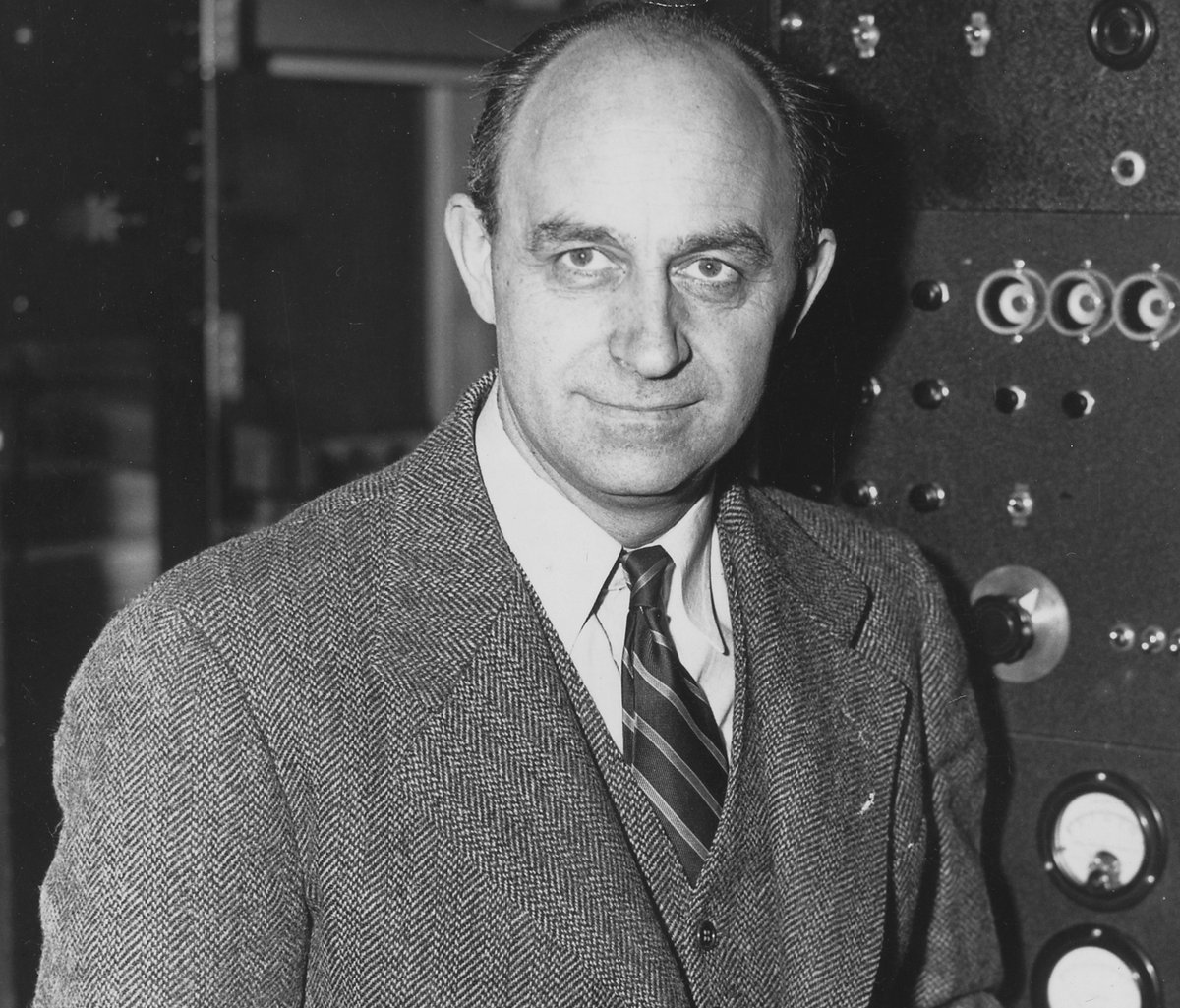
Fermi’s paradox is fairly well known: given what we know about the chance of intelligent life appearing somewhere in the universe, why haven’t any other species to date so far made contact with humanity? You can formalize the paradox via the Drake equation or some other method, but that’s the crux of it.
What’s less clear is how Enrico Fermi originally phrased the paradox. At Language Log, Mark Lieberman points out that each of the participants in the original conversation remembers it differently:
At lunch, Fermi suddenly exclaimed, “Where are they?” (Teller’s remembrance), or “Don’t you ever wonder where everybody is?” (York’s remembrance), or “But where is everybody?” (Konopinski’s remembrance).
As Liberman writes, “our memory of exact word sequences usually fades more quickly than our memory of (contextually interpreted) meanings. More broadly, the exact auditory sensations normally fade very quickly; the corresponding word sequences fade a bit more slowly; and the interpreted meanings last longest.”
My own favorite (for purely aesthetic reasons) is “where is everybody?” It just kind of says everything you want such an observation to say.
Perhaps the Beavers Will Save Us
Beavers are unusual among animals in their ability to radically alter their habitat. They build dams to turn small streams and flood plains into ponds that they use to store food and hide from predators.
It turns out that this is useful for other species who like to radically alter their habitats, like humans. Let’s say you’ve got a dried out flood plain in California you want to restore in order to mitigate the effects of a drought, or even to help stop wildfires. Why not hire some beavers?
The Doty Ravine project cost about $58,000, money that went toward preparing the site for beavers to do their work.
In comparison, a traditional constructed restoration project using heavy equipment across that much land could cost $1 to $2 million, according to Batt…
“It’s huge when you think about fires in California because time is so valuable,” Fairfax said. “If you can stall the fire, if you can stop it from just ripping through the landscape, even if that beaver pond can’t actually stop the fire itself, just stalling it can give the firefighters a chance to get a hold on it.”
These lush green beaver wetlands also protect wildlife that can’t outrun a wildfire.
The weird thing is that humans have been drafting off of beavers literally as long as there have been humans and beavers, especially in North America. Humans come along, find these beautiful ponds and water sources that are perfect for commerce and agriculture, then proceed to trap and kill off the beavers that made it, either directly for their pelts or because the beavers become a nuisance for crops. (Harold Innis, who later became famous for his theories of media and communication, wrote a terrific book about this called The Fur Trade In Canada back in 1930.)
The idea that beavers might be a low-cost, low-impact way to mitigate the destruction of the environment by climate change (and other forms of human meddling) is an attractive one. But we have to be careful not to introduce beavers (or any other species) anyplace where they are unlikely to thrive, or where they’re just going to come into conflict with humans or other species, starting a cycle of destruction all over again.
From @Seinfeld2000 and @hoodinternet: a supercut of the Seinfeld theme mixed with a hit song from each year of the show. (The Daft Punk works surprisingly well!) (ht @UnlikelyWords)
A History of Regular Expressions and Artificial Intelligence

I have an unusually good memory, especially for symbols, words, and text, but since I don’t use regular expressions (ahem) regularly, they’re one of those parts of computer programming and HTML/EPUB editing that I find myself relearning over and over each time I need it. How did something this arcane but powerful even get started? Naturally, its creators were trying to discover (or model) artificial intelligence.
That’s the crux of this short history of “regex” by Buzz Andersen over at “Why is this interesting?”
The term itself originated with mathematician Stephen Kleene. In 1943, neuroscientist Warren McCulloch and logician Walter Pitts had just described the first mathematical model of an artificial neuron, and Kleene, who specialized in theories of computation, wanted to investigate what networks of these artificial neurons could, well, theoretically compute.
In a 1951 paper for the RAND Corporation, Kleene reasoned about the types of patterns neural networks were able to detect by applying them to very simple toy languages—so-called “regular languages.” For example: given a language whose “grammar” allows only the letters “A” and “B”, is there a neural network that can detect whether an arbitrary string of letters is valid within the “A/B” grammar or not? Kleene developed an algebraic notation for encapsulating these “regular grammars” (for example, a*b* in the case of our “A/B” language), and the regular expression was born.
Kleene’s work was later expanded upon by such luminaries as linguist Noam Chomsky and AI researcher Marvin Minsky, who formally established the relationship between regular expressions, neural networks, and a class of theoretical computing abstraction called “finite state machines.”
This whole line of inquiry soon falls apart, for reasons both structural and interpersonal: Pitts, McCullough, and Jerome Lettvin (another early AI researcher) have a big falling out with Norbert Wiener (of cybernetics fame), Minsky writes a book (Perceptrons) that throws cold water on the whole simple neural network as model of the human mind thing, and Pitts drinks himself to death. Minsky later gets mixed up with Jeffrey Epstein’s philanthropy/sex trafficking ring. The world of early theoretical AI is just weird.
But! Ken Thompson, one of the creators of UNIX at Bell Labs comes along and starts using regexes for text editor searches in 1968. And renewed takes on neural networks come along in the 21st century that give some of that older research new life for machine learning and other algorithms. So, until Skynet/global warming kills us all, it all kind of works out? At least, intellectually speaking.
(Via Jim Ray)
Medieval History with Africa at the Center, Europe at the Margins

A new history of late medieval Ethiopia and its interactions with Europe by historian Verena Krebs does something a little unusual, at least for a professor at a European university: it treats the horn of Africa as the center of civilization that it was, and Europeans as the members of far-flung satellite states that Ethiopians could not help but see them as being.
It’s not that modern historians of the medieval Mediterranean, Europe and Africa have been ignorant about contacts between Ethiopia and Europe; the issue was that they had the power dynamic reversed. The traditional narrative stressed Ethiopia as weak and in trouble in the face of aggression from external forces, especially the Mamluks in Egypt, so Ethiopia sought military assistance from their fellow Christians to the north—the expanding kingdoms of Aragon (in modern Spain), and France. But the real story, buried in plain sight in medieval diplomatic texts, simply had not yet been put together by modern scholars. Krebs’ research not only transforms our understanding of the specific relationship between Ethiopia and other kingdoms, but joins a welcome chorus of medieval African scholarship pushing scholars of medieval Europe to broaden their scope and imagine a much more richly connected medieval world.
The Solomonic kings of Ethiopia, in Krebs’ retelling, forged trans-regional connections. They “discovered” the kingdoms of late medieval Europe, not the other way around. It was the Africans who, in the early-15th century, sent ambassadors out into strange and distant lands. They sought curiosities and sacred relics from foreign leaders that could serve as symbols of prestige and greatness. Their emissaries descended onto a territory that they saw as more or less a uniform “other,” even if locals knew it to be a diverse land of many peoples. At the beginning of the so-called Age of Exploration, a narrative that paints European rulers as heroes for sending out their ships to foreign lands, Krebs has found evidence that the kings of Ethiopia were sponsoring their own missions of diplomacy, faith and commerce.
In fact, it would probably be accurate to say that Ethiopia (which over its long history has included areas now in Eritrea, Somalia, Sudan, Yemen, and parts of Saudi Arabia) was undergoing its own Renaissance, complete with the rediscovery of a lost classical kingdom, Aksum (sometimes called Axum).
Around the third century, Aksum was considered an imperial power on the scale of Rome, China, and Persia. It was part to better understand the historical legacy of Aksum that east Africans circa 1400 reestablished trading ties and military partnerships with their old Roman trading partners — or, in their absence, the Germanic barbarians who’d replaced them.
Europe, Krebs says, was for the Ethiopians a mysterious and perhaps even slightly barbaric land with an interesting history and, importantly, sacred stuff that Ethiopian kings could obtain. They knew about the Pope, she says, “But other than that, it’s Frankland. [Medieval Ethiopians] had much more precise terms for Greek Christianity, Syriac Christianity, Armenian Christianity, the Copts, of course. All of the Orthodox and Oriental Orthodox churches. But everything Latin Christian [to the Ethiopians] is Frankland.”
Louis Armstrong’s Final Recording
It turns out that today (July 5th) is the 50th anniversary of Louis Armstrong’s final recording, made the night before he passed away in 1971. Armstrong, born August 4th, 1901 (he often told people he was born July 4th, 1900) was a month shy of 70 years old.
50 years ago today, Louis Armstrong made his final reel-to-reel tape. After concluding it with “April in Paris” from the “Ella and Louis” album, he went to sleep and passed away. This video contains the final minute of “April in Paris,” directly transferred from that last tape. pic.twitter.com/9zq9jWtiPj
— Louis Armstrong (@ArmstrongHouse) July 5, 2021
What Will the Cannabis Industry Look Like In Ten Years?
(Hi, this is Tim Carmody filling in for Jason this week. Hope you all have had a lovely holiday and are ready for more bloggy goodness here at kottke dot org.)
For a variety of reasons, I recently found myself inside a legal marijuana dispensary for the first time. I wasn’t sure exactly what I expected the retail experience to be like — a liquor store? a coffee shop? a used car lot? the paraphrenelia shops I first checked out as a teenager? — but I was nevertheless surprised.
The closest analogy I can think of is a jewelry store. There was pretty decent security, including a whole separate room for customers to check in, and everything was presented in a secure display case. A salesperson walked you through the samples to answer questions, guide you in one direction or another, and take your order, while the order itself was filled in a secure area away from the showroom. The other shopping experience I’ve had that’s similar was buying medical equipment, which makes some sense given the origin of a lot of retail dispensaries in the medical marijuana era. You could also say it’s a little like a pharmacy (which again, is probably unsurprising).
Some of the setup of dispensaries is a function of legal regulations (do you need to check IDs and differentiate between medical and recreational customers?) and some of it solves some practical problems (weed is expensive and there’s still a viable aftermarket, so you are in principle a target for theft).
But it’s also a question of culture: who’s involved in the transaction as a seller and as a buyer, and what are their assumptions and competencies that they’re bringing to the party (so to speak)?
For instance, today Lifehacker (I know, right?) has a short interview with an entrepreneur who runs dispensaries in California, who comes out of the restaurant industry. (It’s titled “How to Break Into the Legal Weed Industry” which is, I think, a very rare kind of service journalism, or more likely, a simple explainer masquerading as service journalism.)
“My entrance into the cannabis industry was several years ago,” said Captor Capital’s Adam Wilks, who operates dispensaries in California, where he reported the business is “smooth sailing” for the most part. “I had worked in the restaurant industry for major brands, including Pinkberry. When I entered, we were just starting to see traction with federal legalization pushes like the SAFE Banking Act and statewide sweeps. I think I entered during the ‘sweet spot’ period where there was still a lot of excitement about an emerging industry and a lot of big money wasn’t quite ready to take risks. Now, everyone is funneling into cannabis.”
Now, a restaurant is a very different industry and has a very different culture than a pharmacy or jeweler or the marijuana sales industry as it’s existed pre-legalization. One might expect a very different retail experience by people with those competencies and expectations. As people from other industries enter the world of cannabis, an amalgamated lingua franca might start to emerge, or you might get very differentiated experiences in different markets.
There’s an Achewood comic titled “Marijuana is not coffee” that’s about five years old now that compares the emerging legal cannabis industry to coffee shops — not just ubiquitous but gentrified, made completely palatable by the American retail industry’s ability to turn anything into a consumer-friendly experience. The characters also imagine a whole cannabis-specific jargon, on the model of coffee talk. Here’s an excerpt:

I don’t know; someone with more than a passing acquaintance with these shops and their alternatives will have to do the full anthropology. But it does seem to me that with the legalization of marijuana, we are in the process of changing more than who is allowed to get high and who is allowed to get paid without being punished.
This weekend, some Texas-based white supremacists marched through Philadelphia’s Center City. Then they started engaging Philly residents. “Somebody threw a smoke bomb to cover their retreat, and they literally ran away from the people of Philadelphia”
Scientific American, The Guardian, and a number of other publications decided earlier this year to start using the term “climate emergency” when covering climate change. “It’s time for journalism to recognize that the climate emergency is here.”
It’s Time for the FDA to Fully Approve the mRNA Vaccines. “Others may not get immunized unless their employers require it, and many organizations…are waiting for the vaccines to be fully approved before instituting such mandates.”
The US Isn’t Ready for Another Pandemic
Olga Khazan writing for The Atlantic:
After an inept coronavirus response, will the United States do better when the next pandemic strikes? Experts generally agree that America learned from the past year, and that the next public-health crisis won’t be quite as bewildering. But America’s pandemic preparedness still has major gaps, some of which are too big for any one administration to fix. In recent weeks, I’ve called back many of the experts I interviewed over the past 18 months about masks, testing, contact tracing, quarantine, and more. I asked them, “Are we ready for another one?” The short answer is “Not quite.” The long answer is that being truly “ready” will be harder than anyone realizes.
The Trump administration mishandled the American response to Covid-19 so completely that it’s tempting to pin most of the pandemic carnage on him. But the more I read about the pandemic (Michael Lewis’s The Premonition is a recent example), the more I have come to believe that the majority of the American pandemic deaths were baked in, no matter who was President. Trump was definitely a worst-case scenario, but even a more competent person in the White House in Jan 2020 (like Clinton or Sanders or Romney) would not have done so much better. Poor public health infrastructure, politicized government agencies, no mandatory paid leave, an overpriced healthcare system that only works for some, uncoordinated national response (+ federalism), years of defunding government programs, a reactive (rather than proactive) CDC, unhealthy populace, poverty, systemic racism in medicine, entitled individualism, high rate of uninsured people, growing anti-science sentiment — the pandemic was destined to race through the United States like a brush fire no matter what.
Even the European Union, whose member nations do not share many of America’s aforementioned challenges (but have other issues), did only marginally better than the US in preventing Covid deaths. The UK did worse:
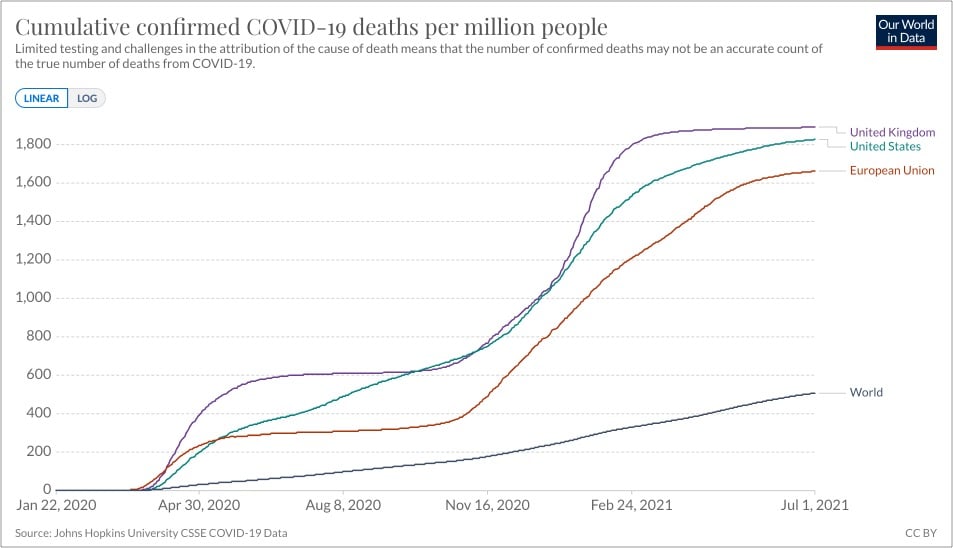
Pig
Hermit Nicolas Cage goes on a crusade to find the person who kidnapped his truffle-hunting pig? Yes, please. (This is going to be terrible, right? Or fantastic? No in-between I’m guessing. Would make an interesting triple feature with The Truffle Hunters .)
Sha’Carri Richardson has been banned from running the 100-meter race in the Tokyo Olympics because she tested positive for marijuana. This is totally totally shitty.
The shitty trend of police officers playing copyrighted music to keep the resulting videos off of social media continues. “You can record all you want. I just know it can’t be posted to YouTube.”
Great Art Explained: van Gogh’s Starry Night
Bear with me, I am on a bit of an art kick lately. As I said earlier this week, I’ve been slowly working my way through James Payne’s Great Art Explained video series. But then — bang! — he came out with a new episode on Vincent van Gogh and his masterpiece, Starry Night. Having seen this painting in person for the first time in a few years just days ago at MoMA, I abandoned the back catalog and dug in to this new one immediately.
Van Gogh is one of my favorites — I spent several happy hours at his museum in Amsterdam in 2017 — and Payne does a good job of contextualizing his life and work around the time he painted Starry Night, particularly the emphasis on the influence of Japanese art on his work and his probable incorporation of spiral galaxy imagery into Starry Night. Highly recommended, especially if you’ve seen the painting in person.
Some Amazing Shots from the Last Decade of Movies
ILM visual effects artist Todd Vaziri asked his Twitter followers to share their favorite shots from a movie made in the last decade. The replies are a visual feast (and heavy on blockbusters) — here are a few of my favorites.

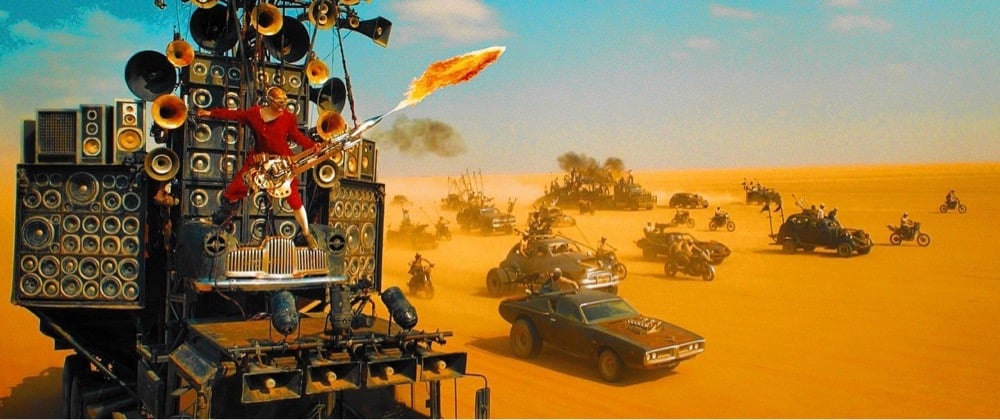

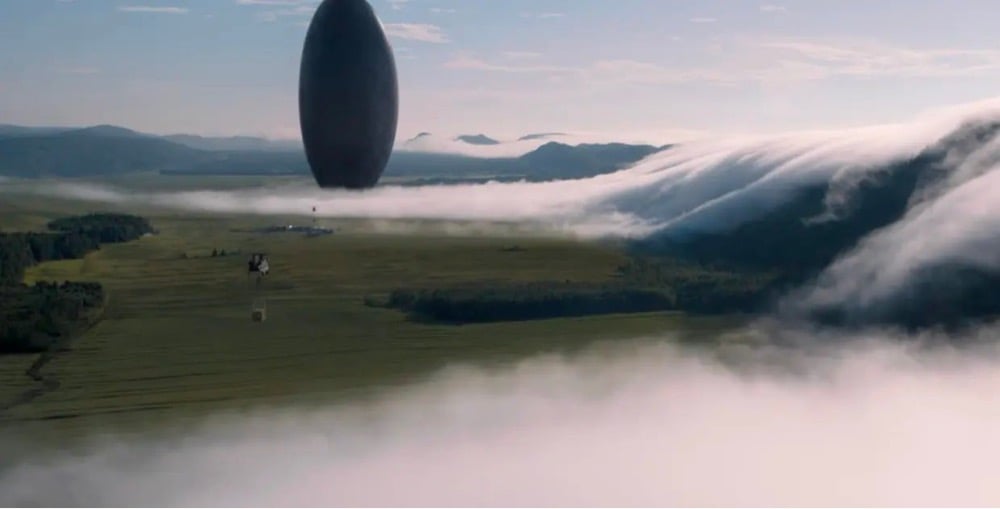

From top to bottom: Blade Runner 2049, Mad Max: Fury Road, Spider-Man: Into the Spider-Verse, Widows, Arrival, and Thor: Ragnarok. There are probably several deserving scenes omitted from the thread (no Wes Anderson fans…the sushi scene from Isle of Dogs?), but that Blade Runner shot is probably my favorite from the decade. I would also have included a shot from Dunkirk (one of the expansive plane chase vistas that looked incredible in IMAX) , Portrait of a Lady on Fire, and the final scene in Carol — that look gives me chills just writing about it.
Update: A video compilation of some of the best shots of the decade.
(via @nielsmann)
A record number of anti-trans bills (131 of them) are moving through the legislations of 36 US states — explore them & their potential impact here. “The goal across these bills is simple: to keep transgender people out of public life.”
Frida Gets Personal
Evan Puschak looks at how the personal nature, intimacy, and stylistic approachability have given Frida Kahlo’s work enduring and increasing popularity.
The danger of the Delta variant of Covid-19. “Vaccinated people are safer than ever despite the variants. But unvaccinated people are in more danger than ever because of the variants.”
App Helps You Build New Creations from Your Existing Lego Pile

A new iOS app called Brickit has been developed to breathe new life into your old Lego pile. Just dump your bricks out into a pile and the app will analyze what Lego bricks you have, what new creations you can build with them, and provide you with detailed build instructions. It can even guide you to find individual pieces in the pile. View a short demo — I’m assuming they’re using some sort of AI/machine learning to do this?
My kids have approximately a billion Legos at my house, so I downloaded Brickit to try it out. The process is a little slow and you need to do a little bit of pre-sorting (by taking out the big pieces and spreading your pile out evenly), but watching the app do its thing is kinda magical. When I have more time later, I’m definitely going to go back and try to build some of the ideas it found for me. (via @marcprecipice)
Inside the Insurrection on Congress
This is an incredible video investigation by the NY Times of the January 6th attack on Congress by terrorists, rioters, and supporters of Donald Trump. They analyzed hundreds of videos, police bodycam footage, and police communications to reconstruct a minute-by-minute account of the Capital breach.
From the accompanying article of six takeaways from the investigation:
Most of the videos we analyzed were filmed by the rioters. By carefully listening to the unfiltered chatter within the crowd, we found a clear feedback loop between President Trump and his supporters.
As Mr. Trump spoke near the White House, supporters who had already gathered at the Capitol building hoping to disrupt the certification responded. Hearing his message to “walk down to the Capitol,” they interpreted it as the president sending reinforcements. “There’s about a million people on their way now,” we heard a man in the crowd say, as Mr. Trump’s speech played from a loudspeaker.
The call and response didn’t stop there. We found evidence of his influence once the violence was well underway. In one moment, a woman with a megaphone urged rioters to climb through a broken window by asking them to “stand up for our country and Constitution” — echoing the language in an earlier tweet from Mr. Trump. In another, as the police were pushing to clear the mob off the building, a rioter screamed at officers: “I was invited here by the president.”
It is astonishing to me how close we came to having a hostage or assassination situation with members of Congress and the Vice-President — like literal seconds and minutes away — and how is this not the only topic of conversation over the past 6 months in our country? And not only that, it’s clear that we’re not really going to do anything about it, aside from beefing up Capitol security and imprisoning some of the insurrectionists. This isn’t over — as the video’s narration states near the end: “The forces that brought them there have not gone away.”
Update: From Brian Stelter’s Reliable Sources newsletter:
But Rangappa could have also been talking about CNN’s efforts in court to obtain riot footage; or ProPublica’s recent investigation that indicated “Senior Trump Aides Knew Jan. 6 Rally Could Get Chaotic;” or Just Security’s new “clearinghouse” for riot research. Her broader point is spot on: Newsrooms have been putting the January 6 puzzle pieces together, creating a detailed rough draft of history, in spite of partisan efforts to bury that history.




Stay Connected